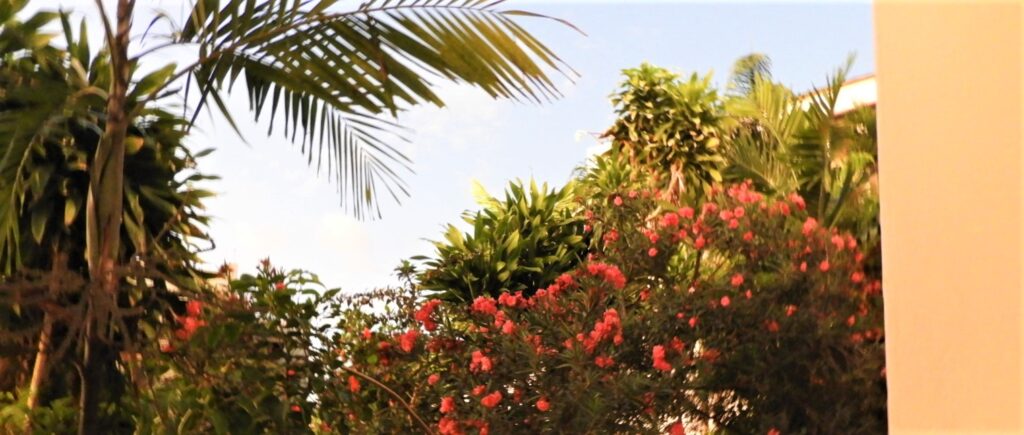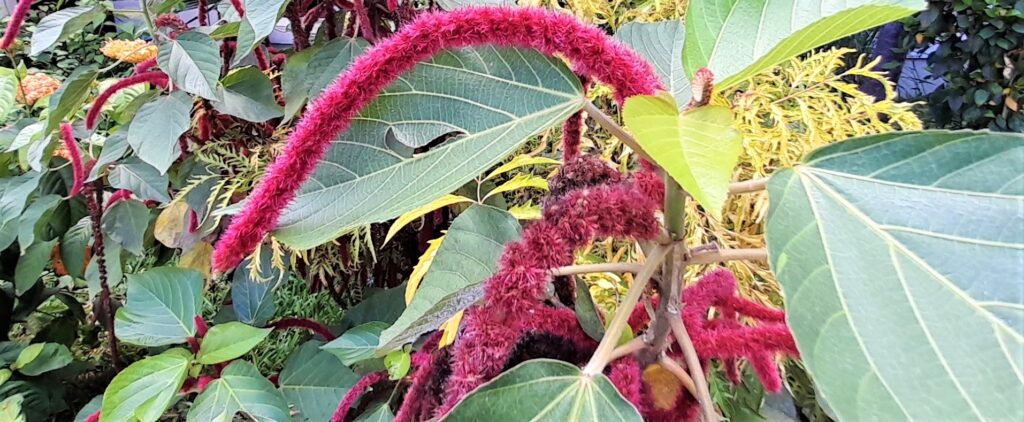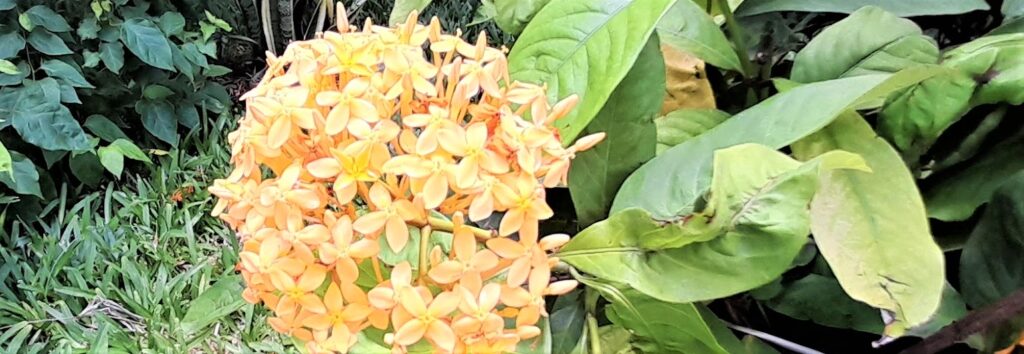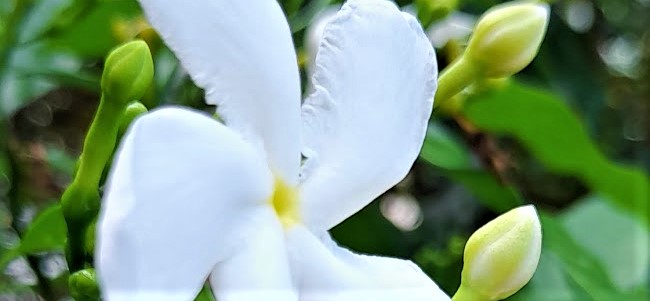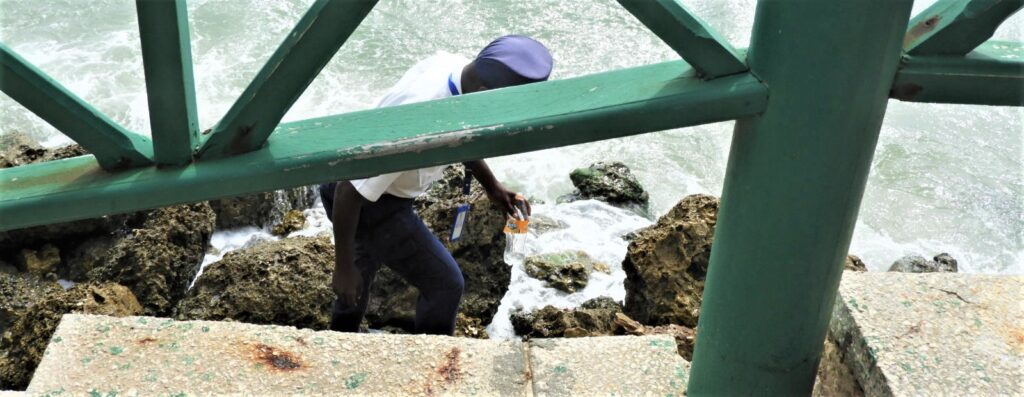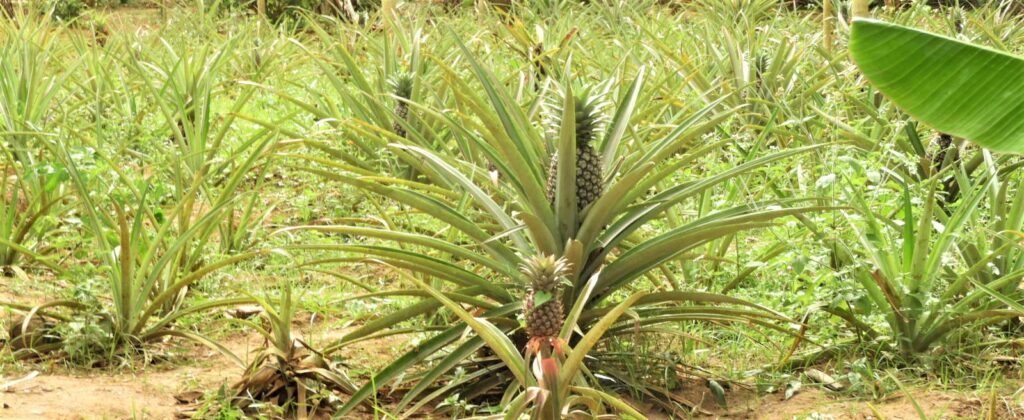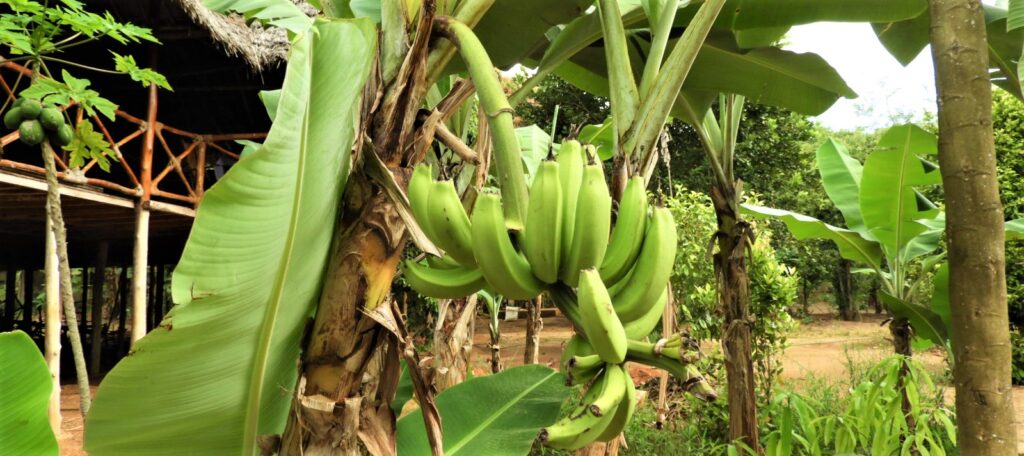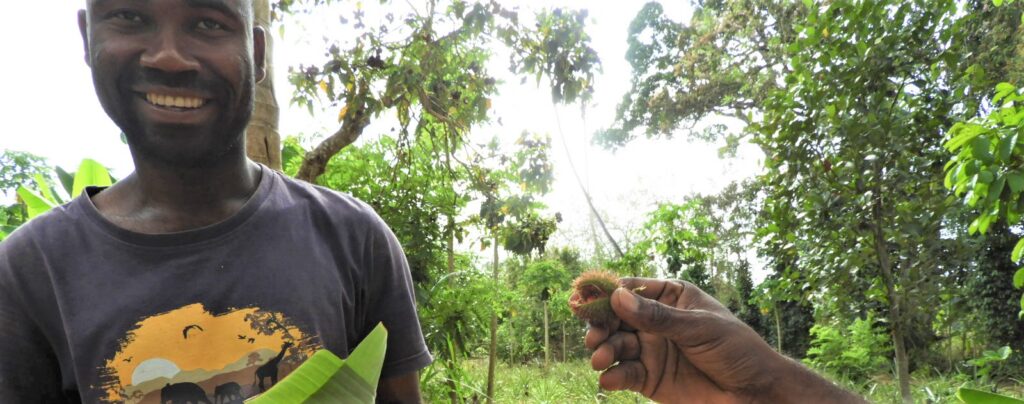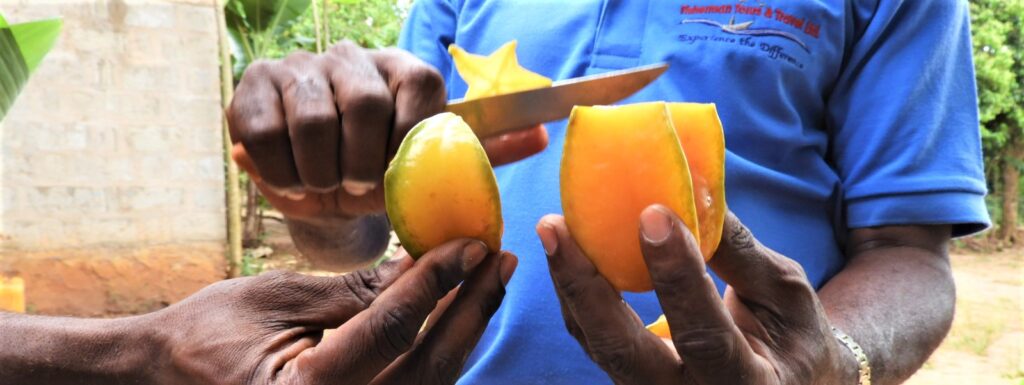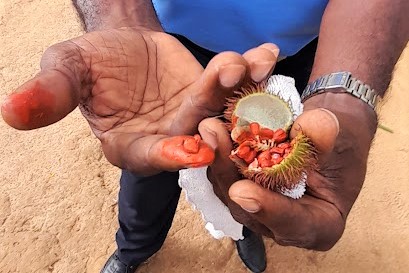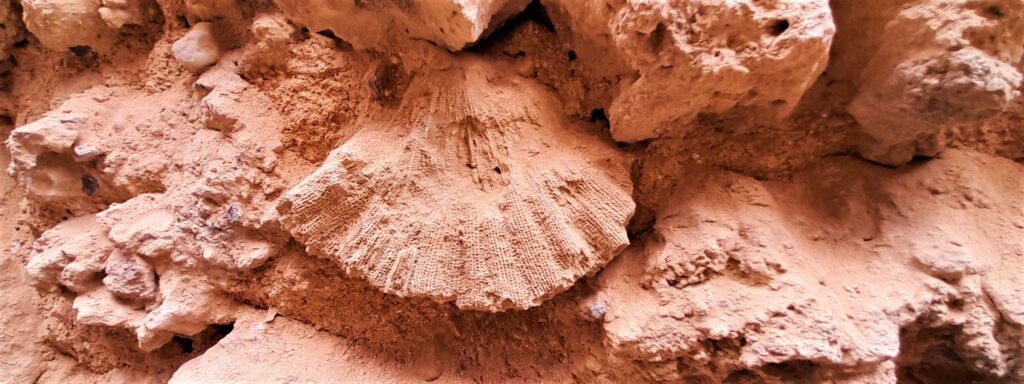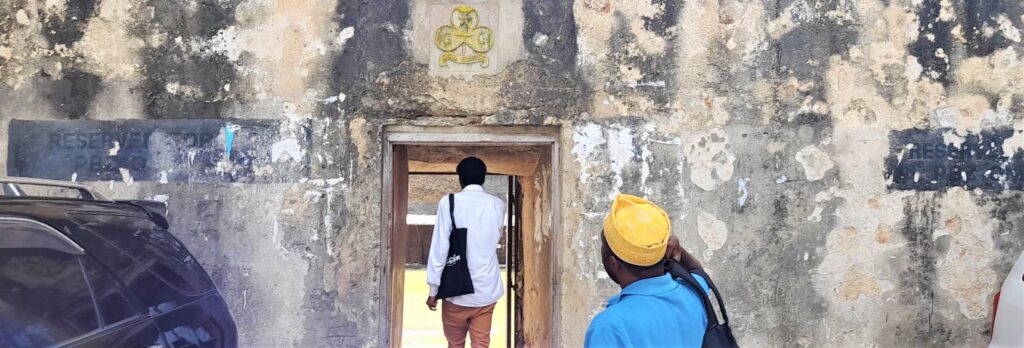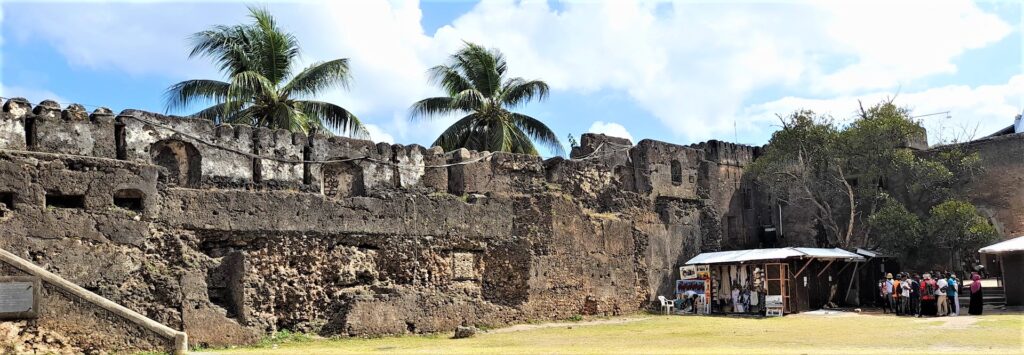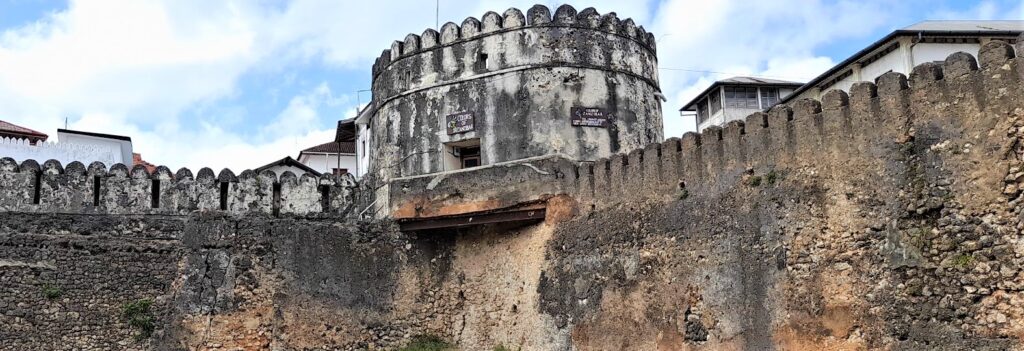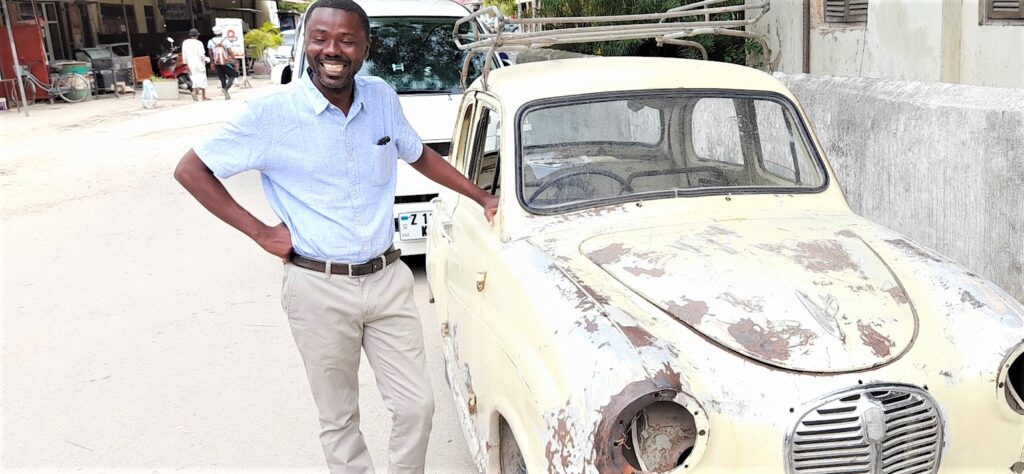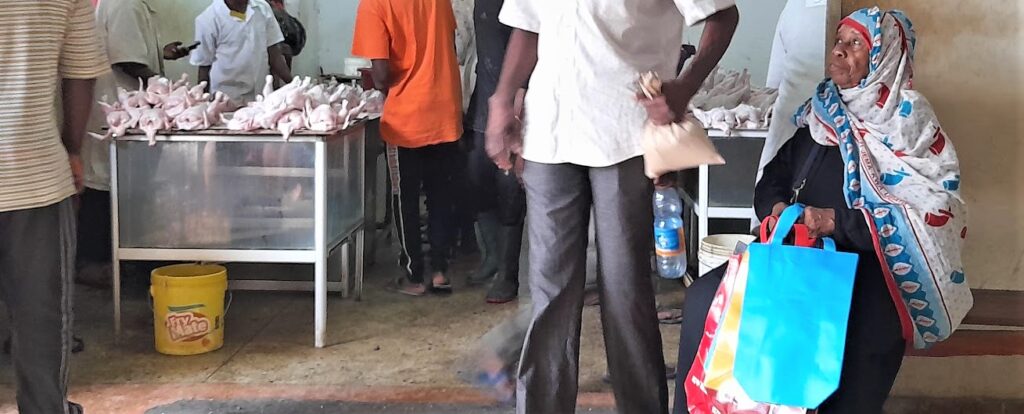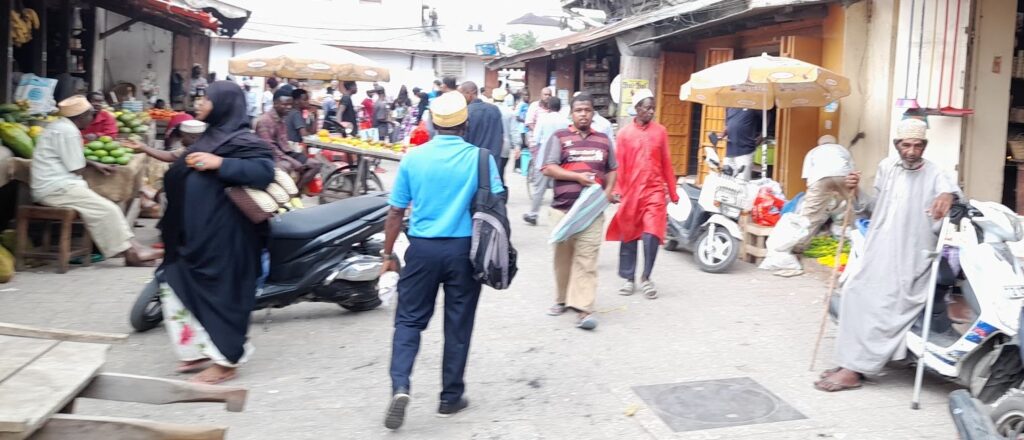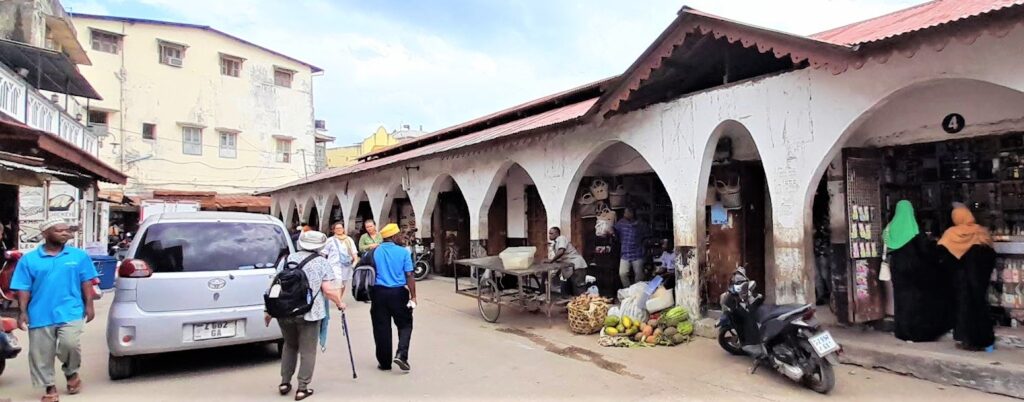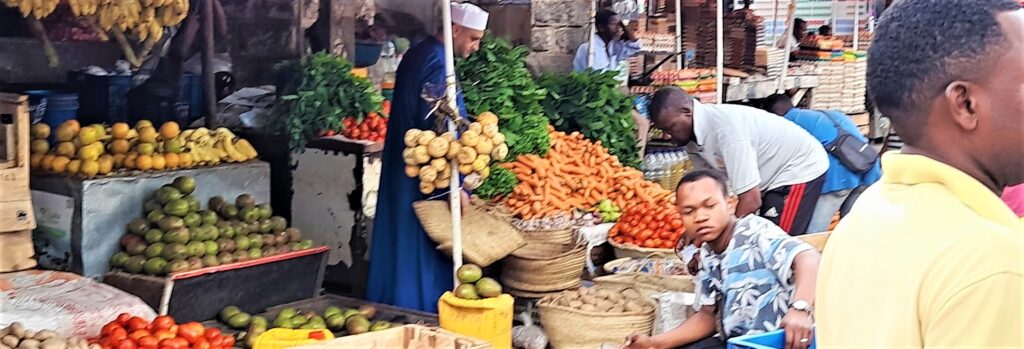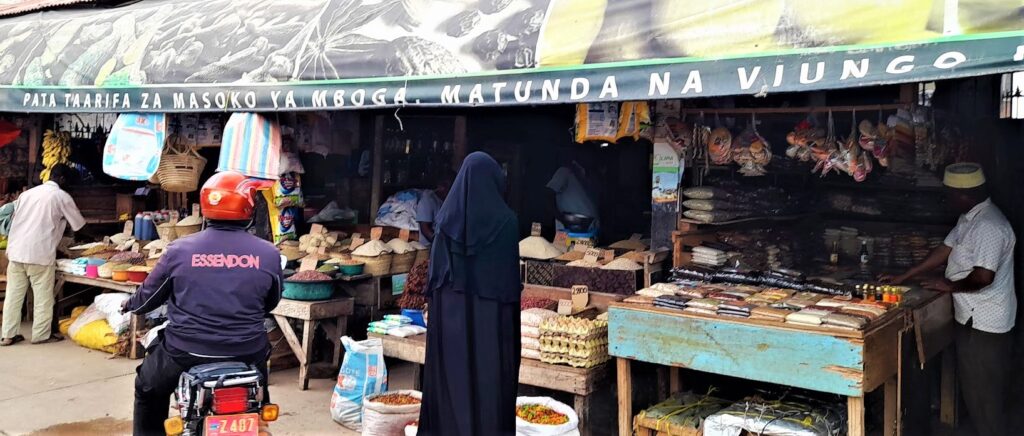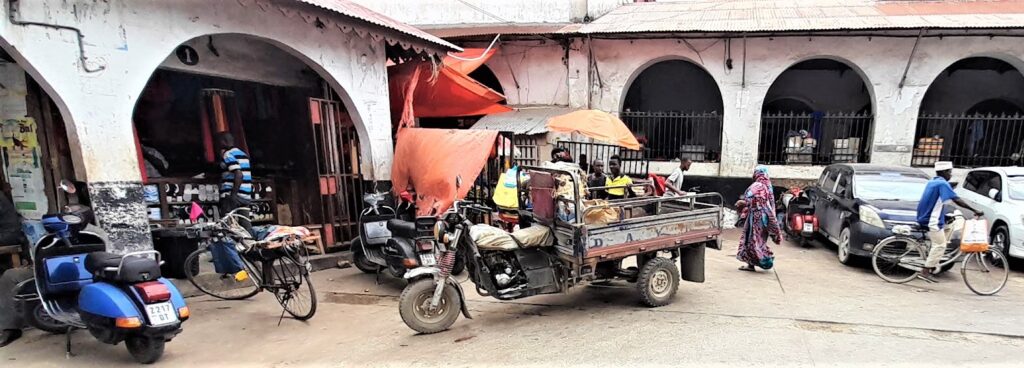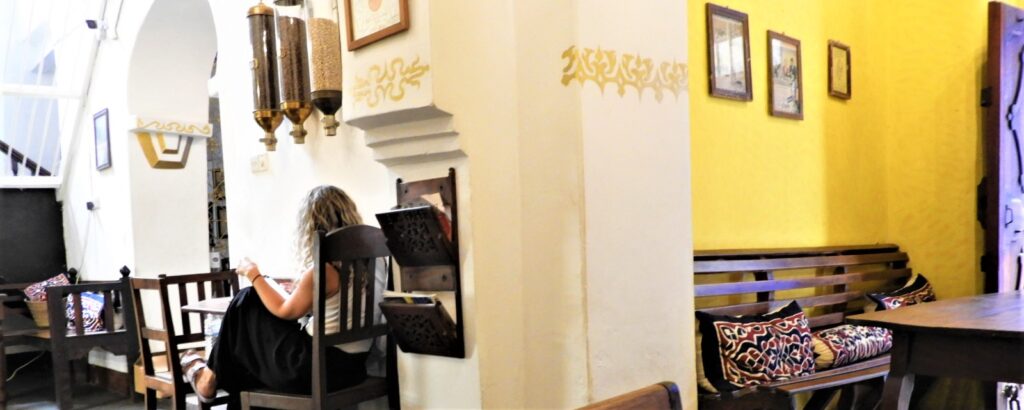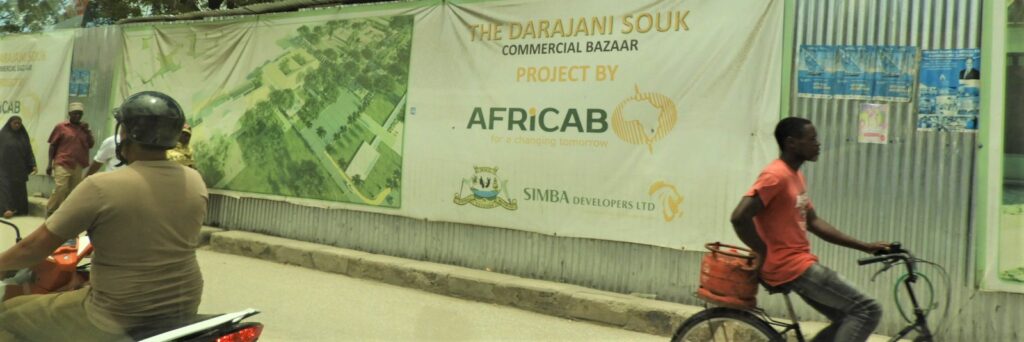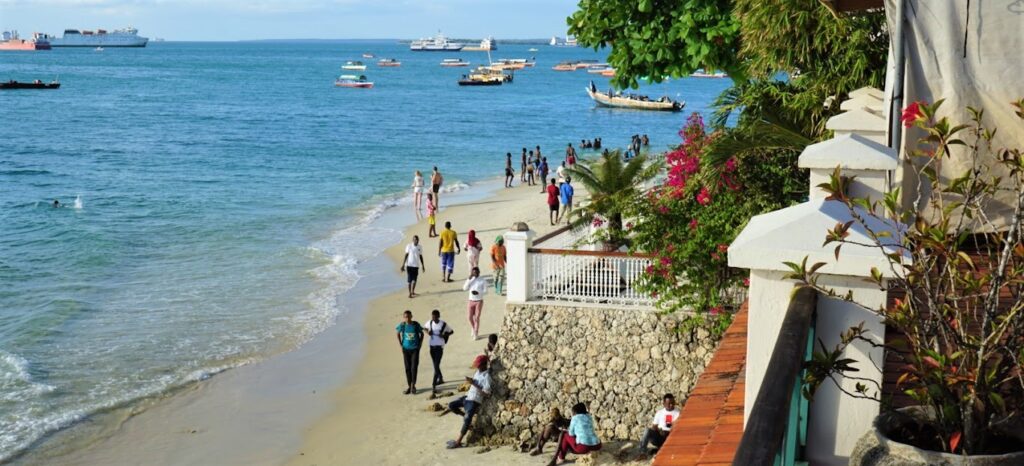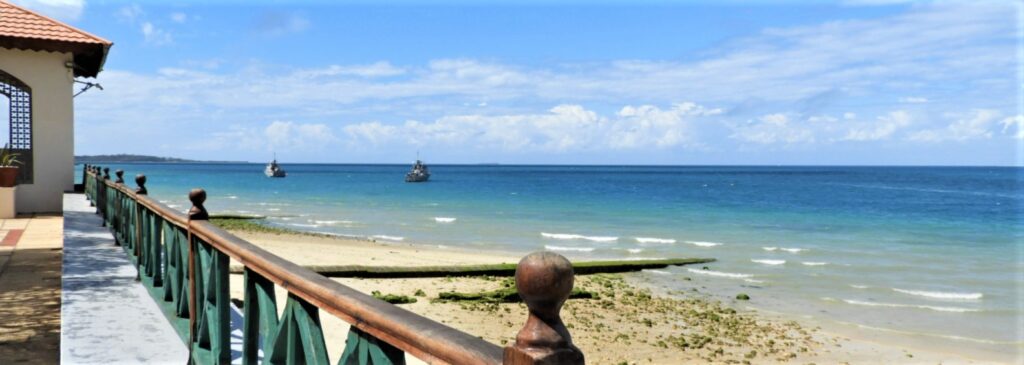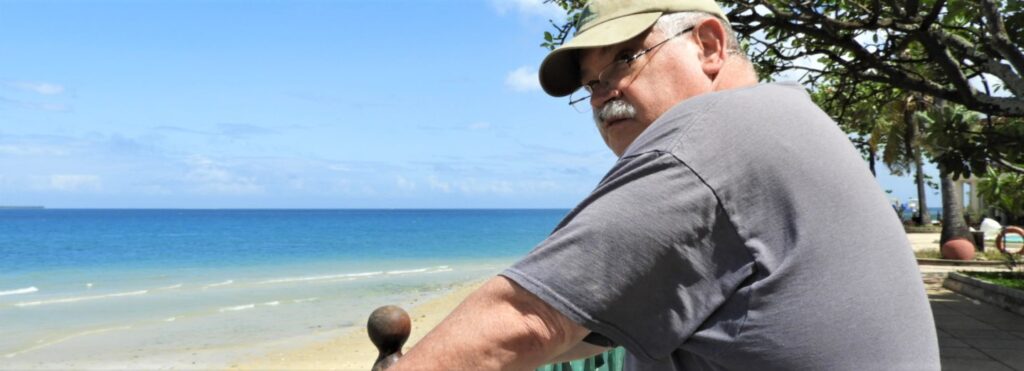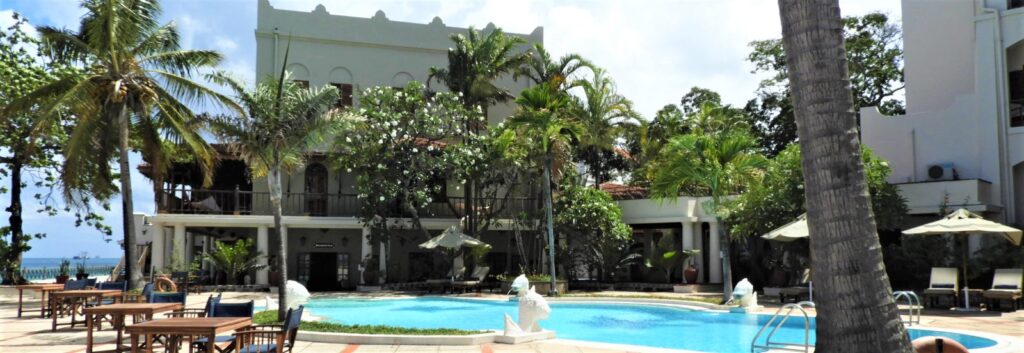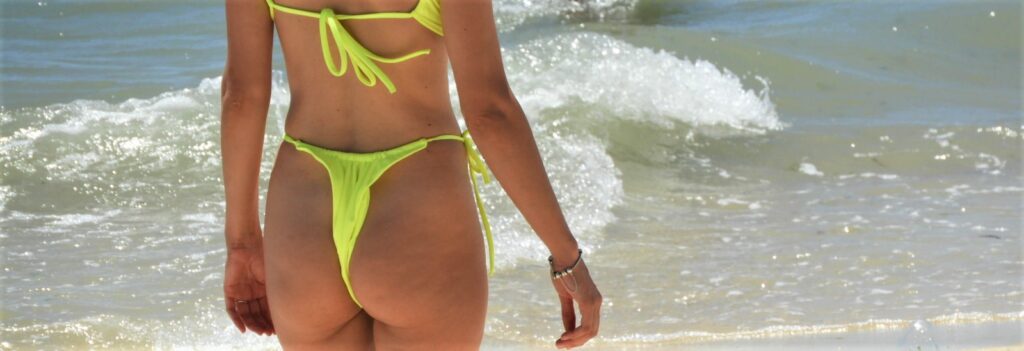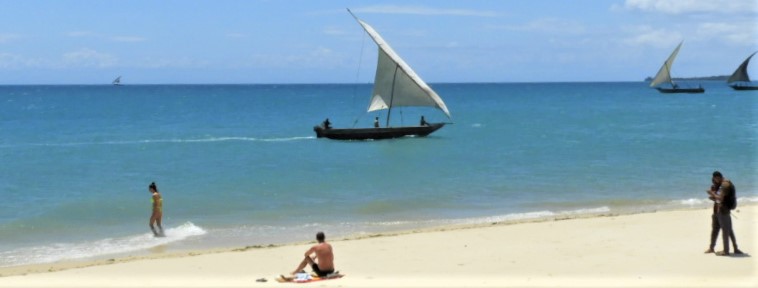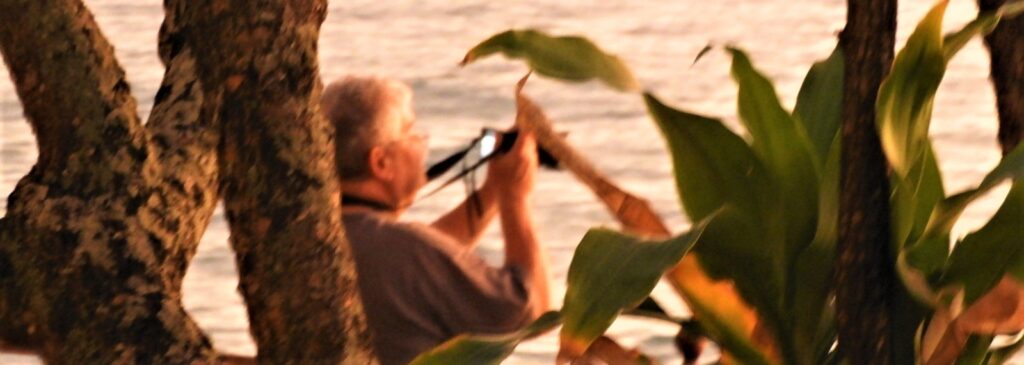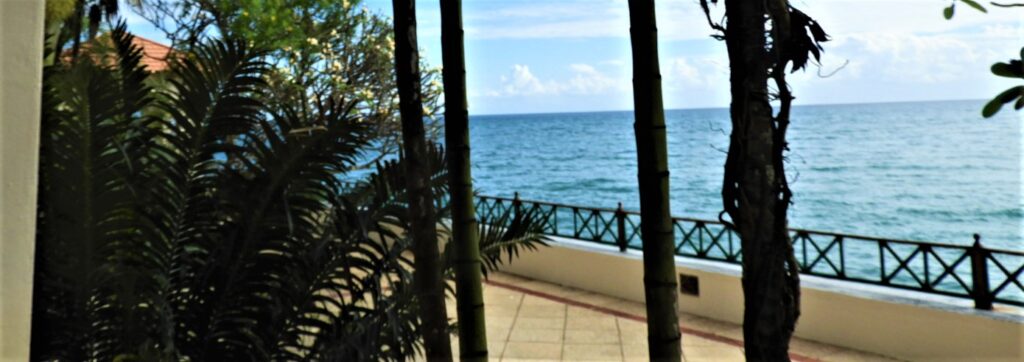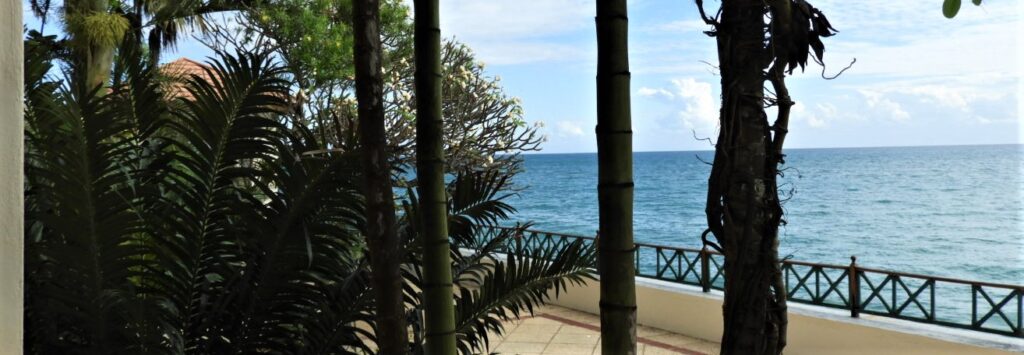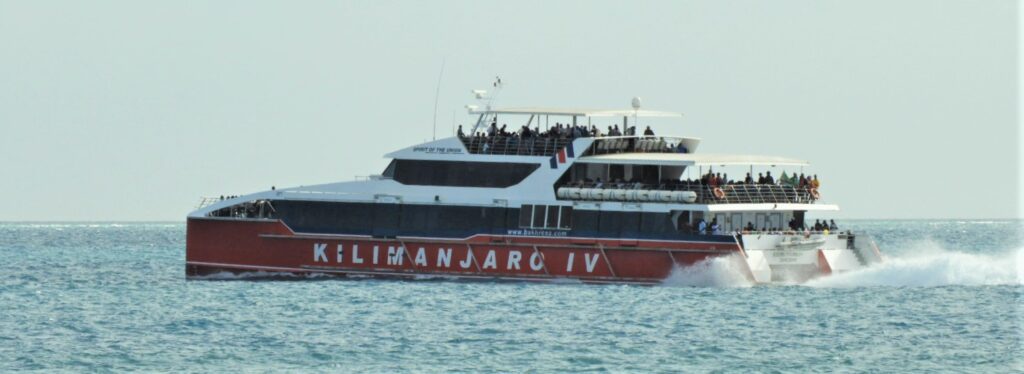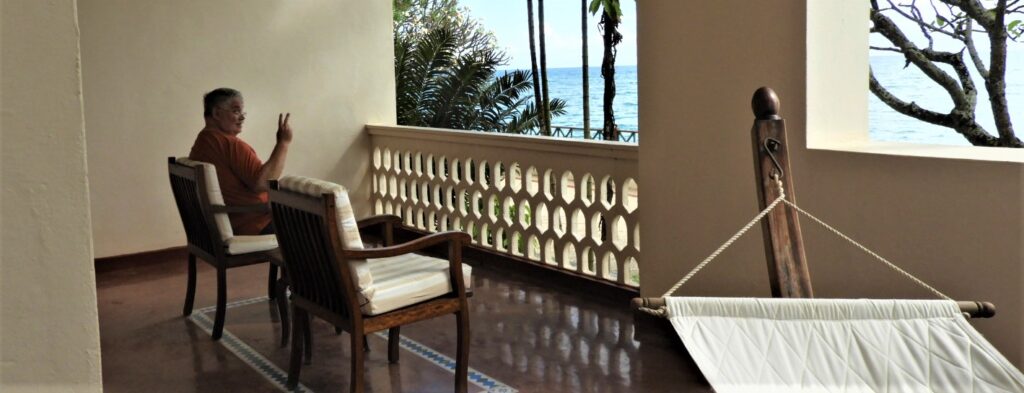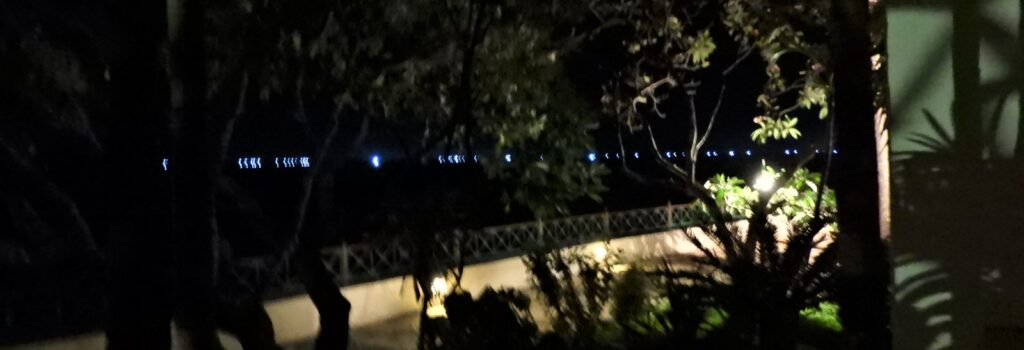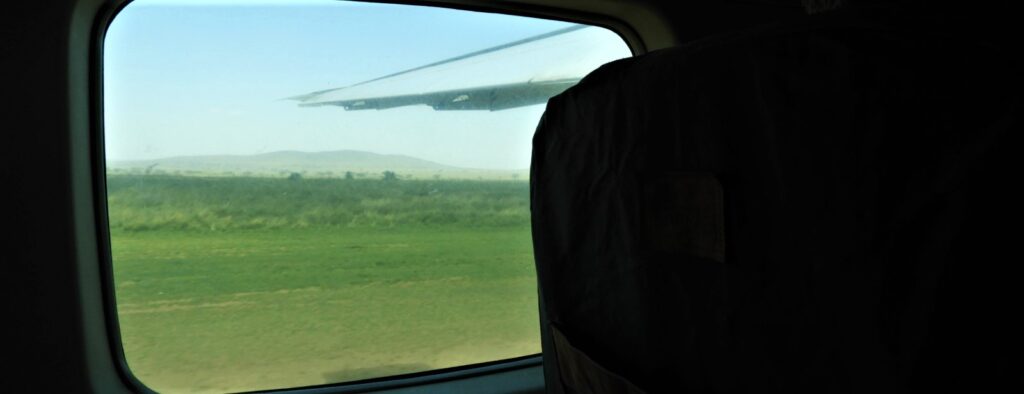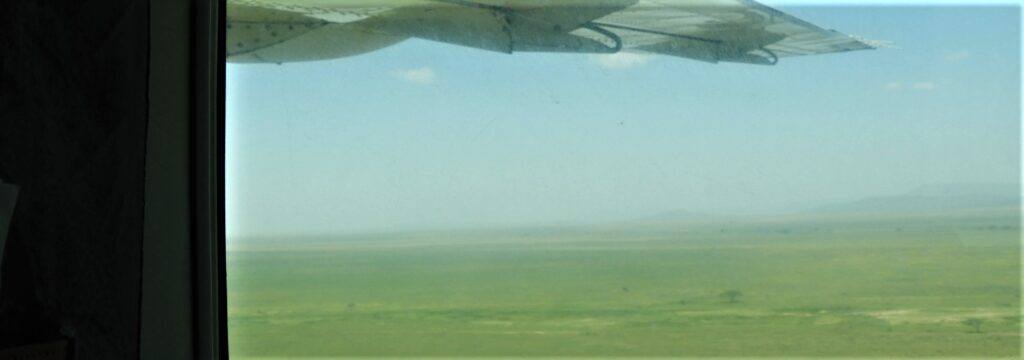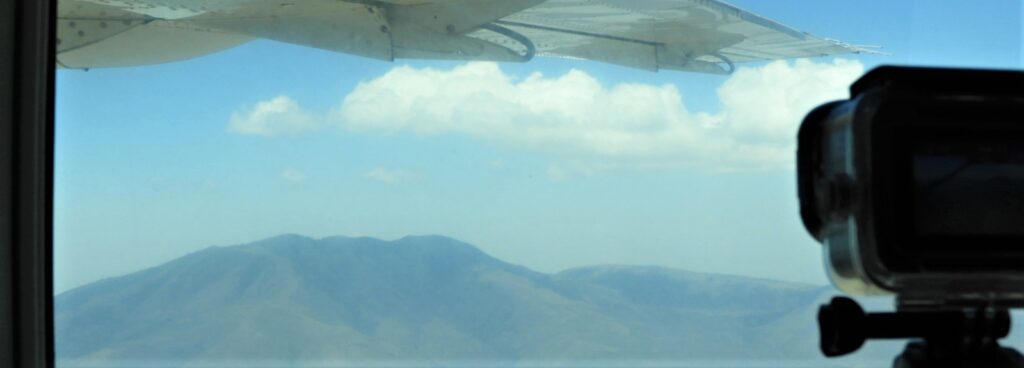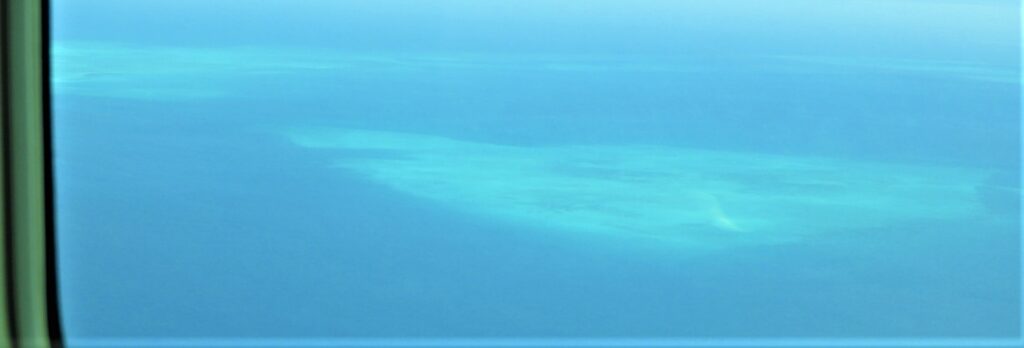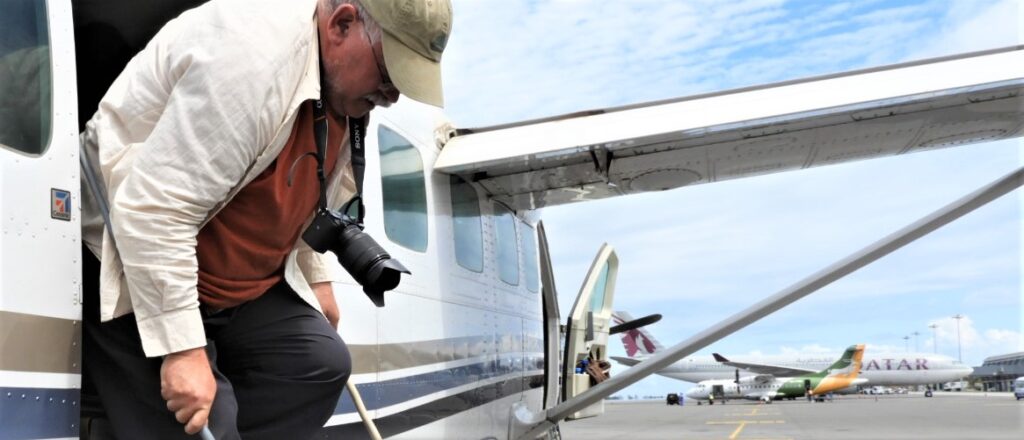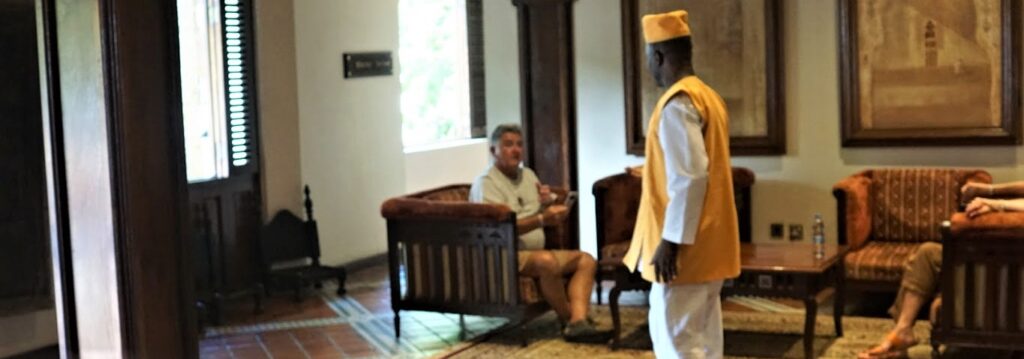Posts Tagged ‘Zanzibar Serena Hotel’
» posted on Tuesday, September 27th, 2022 by Linda Lou Burton
Till Time To Go
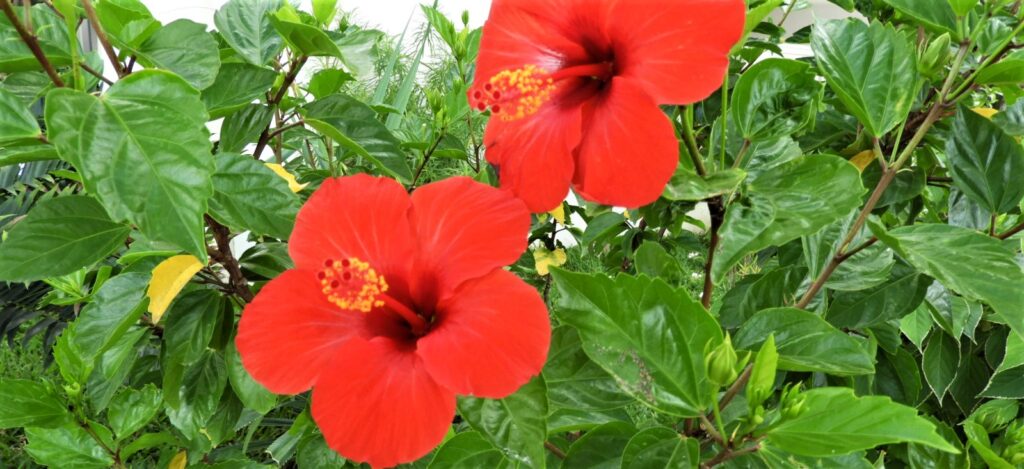 Linda Lou Burton posting from Zanzibar Serena Hotel, Stone Town, Zanzibar, Tanzania –
Linda Lou Burton posting from Zanzibar Serena Hotel, Stone Town, Zanzibar, Tanzania – 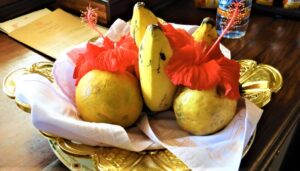 They left a bowl of fruit and flowers in our room when they cleaned every day. I’m sitting on our porch now, eating a banana, thinking about, well, food. People were curious about what we’d eat in Africa. I had studied in advance – what grows there, how it’s prepared, absolute favorites. I vowed to try “at least a bite” of as many different things as I could, although our brains and stomachs tend to crave the familiar. Beans, corn, greens, tomatoes – familiars to me that I knew I’d find in Africa. I knew there would be more dishes featuring bananas and coconut than I have in my routine; I was looking forward to that. So how did it turn out? Here are 10 Things I read about ahead of time:
They left a bowl of fruit and flowers in our room when they cleaned every day. I’m sitting on our porch now, eating a banana, thinking about, well, food. People were curious about what we’d eat in Africa. I had studied in advance – what grows there, how it’s prepared, absolute favorites. I vowed to try “at least a bite” of as many different things as I could, although our brains and stomachs tend to crave the familiar. Beans, corn, greens, tomatoes – familiars to me that I knew I’d find in Africa. I knew there would be more dishes featuring bananas and coconut than I have in my routine; I was looking forward to that. So how did it turn out? Here are 10 Things I read about ahead of time:
- Ugali – maize is a major crop in Kenya and Tanzania. Ugali is standard fare; everybody eats it! Take cornmeal, boil it into a paste; roll it into a ball; eat it with your soups or stews or anything. Like the cornbread I grew up on, only boiled not baked. Did I eat ugali? I honestly don’t know! I tried lots of breads but don’t remember seeing “balled paste” on the Serena buffets. I think I’ll try making it at home, just to be sure.
- Githeri – a favorite in the Kikuyu community; corn and beans, first boiled, then fried. Avocado is often added; all served on rice. Sounds a bit like Mexican food I’ve eaten, agree?
- Ingoho – like the Thanksgiving turkey, Ingoho – chicken – is prepared in Kenya as a special meal; roast the chicken until it is brown; then braise it with onions, tomatoes and spices.
- Kachumbari – claims to be Kenya’s “most delicious salad.” Thin slices of fresh ripe tomatoes, onions, green/red peppers, lemon juice, coriander. I don’t remember seeing the name tag on our buffet’s selections, but every meal had interesting (and beautiful) salads. All delicious.
- Mandazi – oh yes! A very popular sweet! The dough is made with sugar, flour, water, yeast, coconut milk (ground peanuts or almonds can be added). Fry in hot oil, dust with powdered sugar or cinnamon, eat for breakfast or anytime! I remember this one.
- Mchemsho – this means “something boiled” and could be any number of vegetables such as potatoes, green beans, carrots, tomatoes, cabbage, eggplant. Definitely ate this!
- Mukimo –I’ll be making this at home. Mash some potatoes, then add spinach, corn, peas, whatever, for added flavor. I’ve made colcannon (around St Paddy’s day); love it!
- Ndizi na nyama – a favorite in Tanzania this is bananas (ndizi) and meat (nyama) made into a stew with curry powder, cayenne pepper, oil, onions, tomatoes, and coconut milk. Simmer then serve with rice, or ugali! I don’t remember seeing this but I think I’ll try it at home.
- Nyama Choma – Swahili for “grilled meat;” both countries are fond of goat, beef, chicken or fish grilled over charcoal. Our bush meals usually had a grill going for an outdoor feast.
- Rice – rice was everywhere, cooked every which way. In Tanzania, Wali wa nazi is rice cooked in coconut milk and water, seasoned only with salt. In Kenya Pilau is a special rice cooked with spices and chicken or beef.
 Why am I thinking about FOOD as I sit on our porch in Zanzibar, till time to get on a plane headed far, far north? A change awaits us in Iceland, for sure! I’m ticking off their favorites in my head: skyr (kind of like yogurt); ice cream and cheese (yes, they are mad about ice cream!); rye bread and butter (I can dig that); lamb (lamb stew, lamb roasted, lamb sirloin?) and, of course, FISH. Icelanders eat fish every single day. Pretty popular in Zanzibar too, I’m thinking, as another fishing boat goes by. Ali is picking us up at 7, better zip up the old fancy-schmancy suitcase, one more time. Look at these flowers we’ve been enjoying here by the Indian Ocean, while I go back inside a minute. We won’t see them in Iceland!
Why am I thinking about FOOD as I sit on our porch in Zanzibar, till time to get on a plane headed far, far north? A change awaits us in Iceland, for sure! I’m ticking off their favorites in my head: skyr (kind of like yogurt); ice cream and cheese (yes, they are mad about ice cream!); rye bread and butter (I can dig that); lamb (lamb stew, lamb roasted, lamb sirloin?) and, of course, FISH. Icelanders eat fish every single day. Pretty popular in Zanzibar too, I’m thinking, as another fishing boat goes by. Ali is picking us up at 7, better zip up the old fancy-schmancy suitcase, one more time. Look at these flowers we’ve been enjoying here by the Indian Ocean, while I go back inside a minute. We won’t see them in Iceland!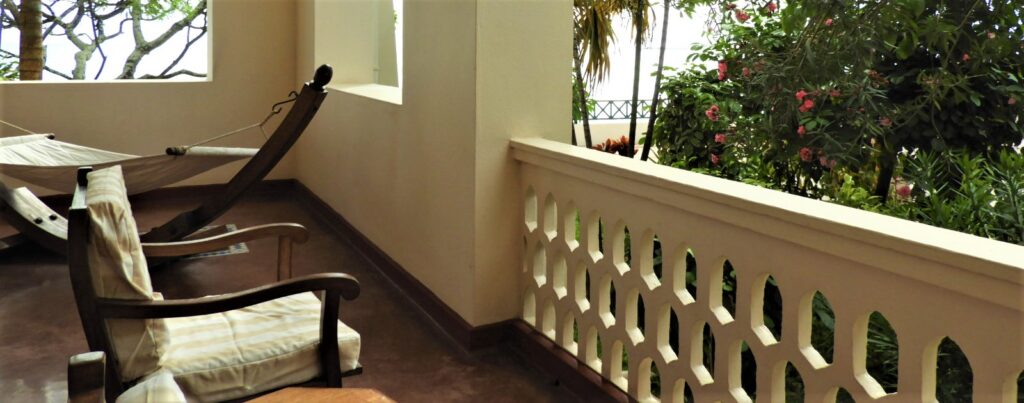
Credit Rick with the flower closeups.
Zanzibar Serena Hotel https://www.serenahotels.com/zanzibar
Fisherman’s Tours https://fishermantours.com/
Next Post: Hot Water
» posted on Tuesday, September 27th, 2022 by Linda Lou Burton
The Guard Made The Day
Linda Lou Burton posting from Zanzibar Serena Hotel, Stone Town, Zanzibar, Tanzania – 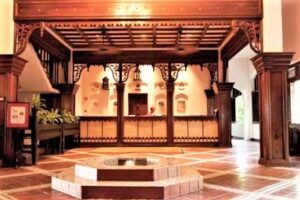 Our plane was not due to leave the airport till 10:30 PM today. It was the only flight this entire week headed from Zanzibar to where we wanted to go. 10:30 PM Tuesday, a flight to Zurich, then Iceland. One flight per week. Otherwise we’d have to fly, or ferry, to the airport on the mainland, Dar es Salaam, 30 miles away; then fly from there. The good thing was – the late flight gave us another full day to enjoy Zanzibar! Our hotel desk was agreeable, no extra charge. Our transport was arranged with Ali from the day before – he’d get us to the airport in plenty of time and
Our plane was not due to leave the airport till 10:30 PM today. It was the only flight this entire week headed from Zanzibar to where we wanted to go. 10:30 PM Tuesday, a flight to Zurich, then Iceland. One flight per week. Otherwise we’d have to fly, or ferry, to the airport on the mainland, Dar es Salaam, 30 miles away; then fly from there. The good thing was – the late flight gave us another full day to enjoy Zanzibar! Our hotel desk was agreeable, no extra charge. Our transport was arranged with Ali from the day before – he’d get us to the airport in plenty of time and  help us through the Tanzanian hoops. So why the heck did Rick have his suitcase zipped and ready to go at 9 AM? There he sat, long warm pants on, long sleeves, decked out for cooler weather. Arms folded, hat on, sitting in a straight-back chair! “Do you want to go on another Tour today?” I asked. “We have plenty of time.” There were
help us through the Tanzanian hoops. So why the heck did Rick have his suitcase zipped and ready to go at 9 AM? There he sat, long warm pants on, long sleeves, decked out for cooler weather. Arms folded, hat on, sitting in a straight-back chair! “Do you want to go on another Tour today?” I asked. “We have plenty of time.” There were  two more Tours that we’d talked about; one to Prison Island, which would give us a cruise on the Indian Ocean for about 30 minutes and the chance to visit with giant tortoises that live there. The Jozani Forest tour was another; it would give us a chance to spot the red colobus monkey, a species that only lives on Zanzibar. But we agreed; our
two more Tours that we’d talked about; one to Prison Island, which would give us a cruise on the Indian Ocean for about 30 minutes and the chance to visit with giant tortoises that live there. The Jozani Forest tour was another; it would give us a chance to spot the red colobus monkey, a species that only lives on Zanzibar. But we agreed; our 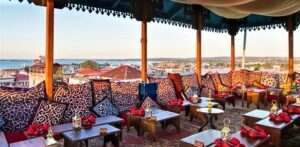 animal count to date was high enough for one trip. We thought about a few restaurants – one in particular, the fancy Tea House where you sat on cushions on the floor, gazing across the rooftops to the sea; the other a hangout bar, named for Freddie Mercury, right on the beach. “Or we can just sit here on our beautiful porch and look at the Indian Ocean,” I said. And then I remembered – I have not yet touched the Indian Ocean – one of my main reasons for being here!
animal count to date was high enough for one trip. We thought about a few restaurants – one in particular, the fancy Tea House where you sat on cushions on the floor, gazing across the rooftops to the sea; the other a hangout bar, named for Freddie Mercury, right on the beach. “Or we can just sit here on our beautiful porch and look at the Indian Ocean,” I said. And then I remembered – I have not yet touched the Indian Ocean – one of my main reasons for being here!
Here’s where our Serena Hotel sits; this point jutting out into the Ocean; facing west, looking towards the mainland. Its history is marvelous; it’s really two historic buildings joined together – an 18th Century Chinese doctor’s home and a 19th Century office building. They were careful, when turning the spaces into a hotel, to preserve the original architecture and the decorative finishes; or to restore them if necessary. It is “Zanzibar Style” – you expect to come face to face with a Sultan any moment. Arabic and Swahili designs, tiles, wood finishes, cool whites and blues. Gardens. One other thing Zanzibar Style means is “close together.” Buildings touch buildings, all around the oceanfront. Our Serena is midway, see the turquoise pool our room overlooks? Below is another view of the hotel, our room is ground floor, right in front of the boat’s sail. The pool is left of the sail, see the umbrellas?
 A Security Guard paced the sidewalk between our porch and the ocean, back and forth, day and night. We’d become nodding acquaintances with our daytime guard; he was a friendly fellow; making sure nobody on the BEACH climbed into our secure hotel space. There was a high wall (for high tide) and a wooden fence above that. Which also kept hotel guests from accessing the beach, directly. I caught his attention, stepped out to ask: “How can I get to the beach?” He told me I’d need to go to Forodhani Park. I pointed to the rickety wooden steps by our pool, behind a locked gate. “Would you unlock the gate and allow me to walk down, just for a minute?” I went into my long story – my plan for dipping my foot into ALL FIVE oceans; I had the first four, this was Number Five. And we were leaving TODAY. I put on my sweetest plaintive smile. He smiled back. “It’s too dangerous,” he said. “Just look.” We peered over the gate together. There was no rail (a bad sign for me, the rail-grabber.) The tide was about halfway out (or in), jagged rocks lay against the base of the wall, water fiercely lapping against stone. “I simply cannot allow you on these steps,” the guard said. “It’s treacherous.” Well in fact, it was, for me, for sure. “I just need the WATER,” I said. “I don’t need to walk ON the beach. So, would you walk down a few steps, get some Indian Ocean water on your hands, and then just SPRINKLE it on my feet?” This set off so much laughter between the guard and Rick; so many grins exchanged over an old lady’s head, that, next thing you know, he unlocked that gate and headed down those treacherous steps.
A Security Guard paced the sidewalk between our porch and the ocean, back and forth, day and night. We’d become nodding acquaintances with our daytime guard; he was a friendly fellow; making sure nobody on the BEACH climbed into our secure hotel space. There was a high wall (for high tide) and a wooden fence above that. Which also kept hotel guests from accessing the beach, directly. I caught his attention, stepped out to ask: “How can I get to the beach?” He told me I’d need to go to Forodhani Park. I pointed to the rickety wooden steps by our pool, behind a locked gate. “Would you unlock the gate and allow me to walk down, just for a minute?” I went into my long story – my plan for dipping my foot into ALL FIVE oceans; I had the first four, this was Number Five. And we were leaving TODAY. I put on my sweetest plaintive smile. He smiled back. “It’s too dangerous,” he said. “Just look.” We peered over the gate together. There was no rail (a bad sign for me, the rail-grabber.) The tide was about halfway out (or in), jagged rocks lay against the base of the wall, water fiercely lapping against stone. “I simply cannot allow you on these steps,” the guard said. “It’s treacherous.” Well in fact, it was, for me, for sure. “I just need the WATER,” I said. “I don’t need to walk ON the beach. So, would you walk down a few steps, get some Indian Ocean water on your hands, and then just SPRINKLE it on my feet?” This set off so much laughter between the guard and Rick; so many grins exchanged over an old lady’s head, that, next thing you know, he unlocked that gate and headed down those treacherous steps.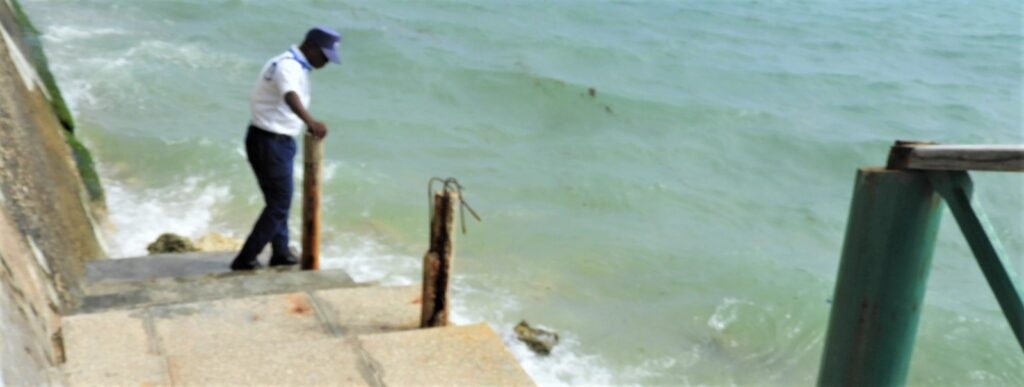

 He was WADING in the waves; his shoes, his PANTS were getting soaked. “Just a teeny bit of water is OK!” I shouted down. “Be careful!” And then, he spotted a plastic bottle floating, banging against the rocks. This (precious, sweetheart) guard grabbed it, rinsed it out, and hopped back up the steps with an entire BOTTLE of Indian Ocean water! He poured it on my left foot! He poured it on my right foot! He laughed! Rick laughed! I squealed like a kid! Sometimes the most unexpected thing can lead to a tick mark on a bucket list. Ocean #5 is now on my feet! Just 78 years after Ocean #1.
He was WADING in the waves; his shoes, his PANTS were getting soaked. “Just a teeny bit of water is OK!” I shouted down. “Be careful!” And then, he spotted a plastic bottle floating, banging against the rocks. This (precious, sweetheart) guard grabbed it, rinsed it out, and hopped back up the steps with an entire BOTTLE of Indian Ocean water! He poured it on my left foot! He poured it on my right foot! He laughed! Rick laughed! I squealed like a kid! Sometimes the most unexpected thing can lead to a tick mark on a bucket list. Ocean #5 is now on my feet! Just 78 years after Ocean #1. 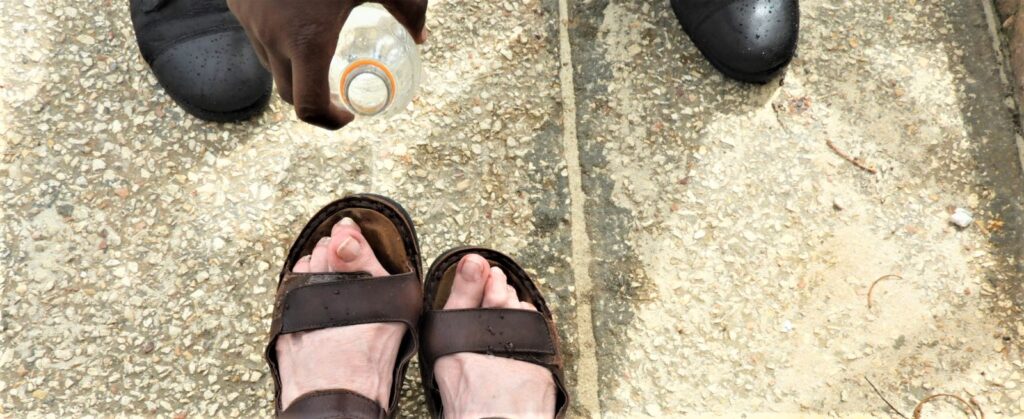
The guard made my day. Of course I tipped him generously!
Zanzibar Serena Hotel https://www.serenahotels.com/zanzibar
Fisherman’s Tours https://fishermantours.com/
Next Post: Till Time To Go
» posted on Monday, September 26th, 2022 by Linda Lou Burton
A Spicy Afternoon
Linda Lou Burton posting from Zanzibar Serena Hotel, Stone Town, Zanzibar, Tanzania – 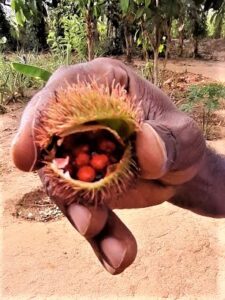 Cinnamon is tree bark. A pineapple plant produces only ONE pineapple. And the lipstick tree (no, I’m not kidding) has little red berries inside its spiny smooch-smooch pod that some people (have been known to) use to redden their lips. All of this was news to me! Cinnamon is TREE BARK? That’s right, that beloved wonderful-smelling stuff Mother would sprinkle on toast for me (a picky-eater-kid) comes from the bark of a tree. Imagine this: you scrape off the outer bark of a cinnamon tree (it’s an evergreen); then you cut out the inner bark, in strips. As the bark dries, it rolls into a
Cinnamon is tree bark. A pineapple plant produces only ONE pineapple. And the lipstick tree (no, I’m not kidding) has little red berries inside its spiny smooch-smooch pod that some people (have been known to) use to redden their lips. All of this was news to me! Cinnamon is TREE BARK? That’s right, that beloved wonderful-smelling stuff Mother would sprinkle on toast for me (a picky-eater-kid) comes from the bark of a tree. Imagine this: you scrape off the outer bark of a cinnamon tree (it’s an evergreen); then you cut out the inner bark, in strips. As the bark dries, it rolls into a  curl. The dried curls are cut into “quills” 2-4 inches long for sale. Somehow or other this delicious tree bark winds up powdered on bread making cinnamon toast for picky kids. Or cinnamon rolls for everybody. We couldn’t even have Halloween Red Hots without that fragrant tree bark! That’s just part of what we learned this afternoon at the Jambo Spice Farm, where things that sit in everybody’s kitchen cabinet take on an exotic aura. Like cloves, the “Emperor of Spices”; like nutmeg, turmeric, cardamom, black pepper. You should have been there!
curl. The dried curls are cut into “quills” 2-4 inches long for sale. Somehow or other this delicious tree bark winds up powdered on bread making cinnamon toast for picky kids. Or cinnamon rolls for everybody. We couldn’t even have Halloween Red Hots without that fragrant tree bark! That’s just part of what we learned this afternoon at the Jambo Spice Farm, where things that sit in everybody’s kitchen cabinet take on an exotic aura. Like cloves, the “Emperor of Spices”; like nutmeg, turmeric, cardamom, black pepper. You should have been there!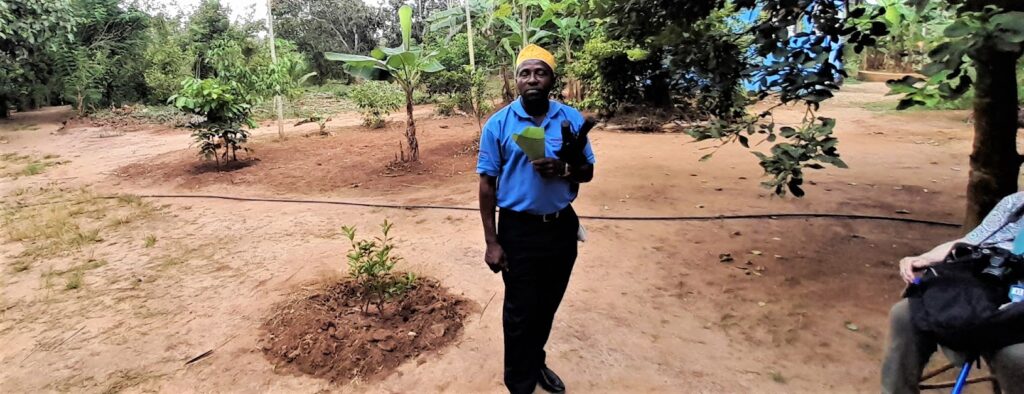
Ali drove, and Said led the tour, along with locals on the farm; a jungley maze of green to wander through on a warm afternoon. No crowds, no hurry, just stop, look, smell, and taste. Touch a banana while it’s hanging on the tree, still growing. Watch a brave soul shimmy up a 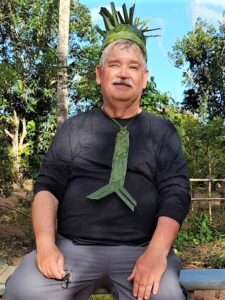 coconut tree while everyone below chants him higher, higher, daring. Rick wound up with a hat and a tie made of woven coconut leaves (and he didn’t have to climb the tree). I gained a new appreciation for the gardening tactics regarding pineapple. Cut off the top and plant it so it can make another plant. Eat the pineapple fruit. Repeat. As for the lipstick tree: those bright red berries actually are used in industrial dyes for food preparation and cosmetics. My vote for prettiest just-off-the-tree spice was the nutmeg – once you open the outer shell it looks like you’ve lucked into a fancily-decorated chocolate bon-bon. Don’t you think?
coconut tree while everyone below chants him higher, higher, daring. Rick wound up with a hat and a tie made of woven coconut leaves (and he didn’t have to climb the tree). I gained a new appreciation for the gardening tactics regarding pineapple. Cut off the top and plant it so it can make another plant. Eat the pineapple fruit. Repeat. As for the lipstick tree: those bright red berries actually are used in industrial dyes for food preparation and cosmetics. My vote for prettiest just-off-the-tree spice was the nutmeg – once you open the outer shell it looks like you’ve lucked into a fancily-decorated chocolate bon-bon. Don’t you think?
Jambo Spice Farm is a 30-minute drive from Stone Town, in a cluster of spice-growing farms – Abeid, Badru, SISO, Tangawizi; and near the Zanzibar Agricultural Research Institute and the School of Agriculture. The drive passes along the coastline, turning eastward at Bububu.
Why do spices grow so profusely in Zanzibar? Perfect soil and climate – plenty of rain and always, always warm.
Zanzibar Serena Hotel https://www.serenahotels.com/zanzibar
Fisherman’s Tours https://fishermantours.com/
Zanzibar School of Agriculture https://suza.ac.tz/soa/
Next Post: The Guard Made The Day
» posted on Monday, September 26th, 2022 by Linda Lou Burton
Food, Facts, & A Fort
Linda Lou Burton posting from Zanzibar Serena Hotel, Stone Town, Zanzibar, Tanzania – Who doesn’t love pizza? The minute I saw “pizza” on the menu I knew that’s what I was ordering. I’d read about “Zanzibar Pizza” and was dying to try it – not Italian pizza, but Zanzibar pizza. You take unleavened dough, stretch it thin and fill it with beef, chicken, seafood, vegetables, cheese, eggs, whatever you please. Then you wrap the sides around, throw it into a pan full of butter, and fry it to a crispy gold! You can also make it sweet: bananas, mangoes, chocolate spread, even peanut butter. We’d had our Zanzibar coffee  earlier, now with the Walking Tour done, Rick and I were in a tiny restaurant-by-the-sea for our lunch break. Said and Ali would fetch us later for our ride south to the Spice Farm. Lots to talk about – Rick had wandered through several hundred years of civilization in the last few hours. Stone Town is on Unguja, the largest of the Zanzibar Archipelago’s four main islands; it is 53 miles long and 24 miles wide, about 25 miles from Tanzania’s mainland. Zanzibar’s population (all islands) is under 2 million. Zanzibar City, of which Stone Town is a part, is the capital of this semi-autonomous province-within-a-country. That’s the geography. We needed to get Zanzibar’s HISTORY unscrambled in our heads, so, dates next.
earlier, now with the Walking Tour done, Rick and I were in a tiny restaurant-by-the-sea for our lunch break. Said and Ali would fetch us later for our ride south to the Spice Farm. Lots to talk about – Rick had wandered through several hundred years of civilization in the last few hours. Stone Town is on Unguja, the largest of the Zanzibar Archipelago’s four main islands; it is 53 miles long and 24 miles wide, about 25 miles from Tanzania’s mainland. Zanzibar’s population (all islands) is under 2 million. Zanzibar City, of which Stone Town is a part, is the capital of this semi-autonomous province-within-a-country. That’s the geography. We needed to get Zanzibar’s HISTORY unscrambled in our heads, so, dates next.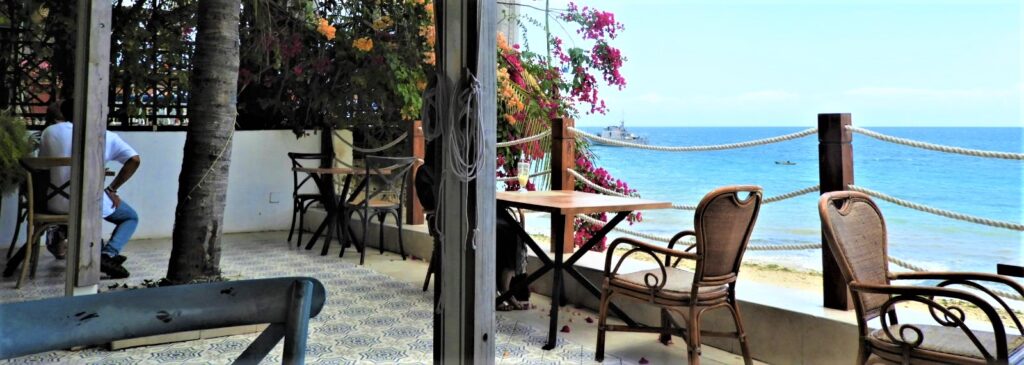
10 Significant Dates (among many!):
- 1498 – Portugal’s Vasco da Gama visited the islands
- 1571 – Zanzibar became part of the Portuguese Empire
- 1635 – Portuguese established a fort on Pemba Island
- 1698 – Zanzibar came under influence of the Sultan of Oman
- 1699 –Omani’s expelled the Portuguese, built fort in Stone Town
- 1784 – Brief revolt against Omani rule
- 1890 – Zanzibar became a protectorate of Great Britain
- 1963 – British protectorate terminated, Zanzibar became monarchy
- 1964 – Sultan deposed, Zanzibar became Peoples Republic
- 1964 – Zanzibar merged with Tanganyika to become Tanzania
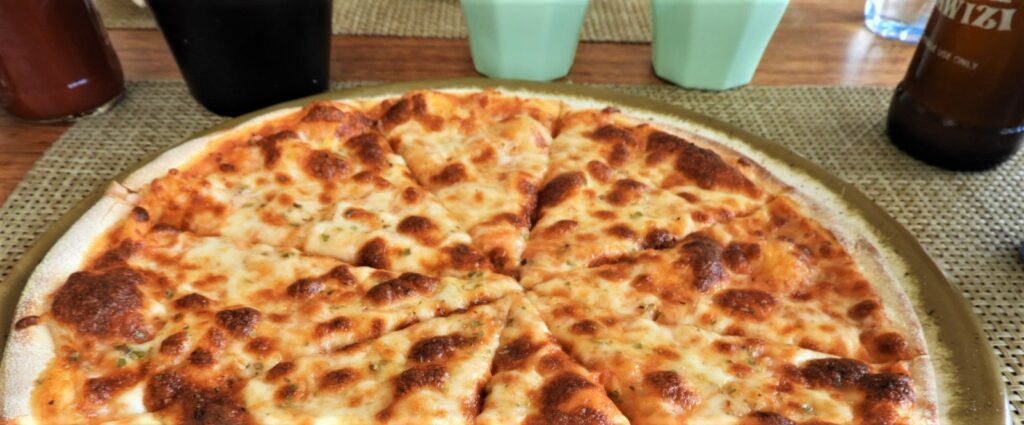 Oops, here are our pizzas, looking very American. “Sorry, we don’t serve Zanzibar pizza here,” our server explained. Okay then, something familiar! “Just tell me about two things you saw this morning,” I said to Rick as I scarfed down my cheesy pizza. “Your favorites.”
Oops, here are our pizzas, looking very American. “Sorry, we don’t serve Zanzibar pizza here,” our server explained. Okay then, something familiar! “Just tell me about two things you saw this morning,” I said to Rick as I scarfed down my cheesy pizza. “Your favorites.”
His picks: the coral stone used for building construction and the Old Fort.
Stone Town was named “Stone Town” because its buildings were mainly built with coral stone, giving the town a warm color. Look at this alley wall!
The Old Fort is on the main seafront, by the House of Wonders, facing Forodhani Gardens. History: it was built by Omani Arabs after chasing away the Portuguese in 1699. It was used as a garrison and prison in the 19th century. In the early 20th century it was a depot as the railway that connected Stone Town to the village of Bububu (named for the sound a steam engine makes as it passes by bububububu) was being constructed. A new guardhouse was built in 1947 and used as the ladies’ club. And, thoroughly modern — its amphitheater is now the headquarters of the Zanzibar international film festival!
Zanzibar Serena Hotel https://www.serenahotels.com/zanzibar
Fisherman’s Tours https://fishermantours.com/
Next Post: A Spicy Afternoon
» posted on Monday, September 26th, 2022 by Linda Lou Burton
To Market, To Market
Linda Lou Burton posting from Zanzibar Serena Hotel, Stone Town, Zanzibar, Tanzania –  A fat pig is about the only thing I didn’t see in Darajani Market this morning. Zanzibar is 99% Muslim, and since pork isn’t an approved dietary item in the Islamic religion, you wouldn’t expect to see it in local stores, or on restaurant menus. Beef, chicken, and goat are on the approved list, as well as seafood; so in a country right on the ocean’s coastline, it makes sense that the Fish Market was the first spot I caught a whiff of. The “morning catch”? I’d watched the fishing boats from my porch at
A fat pig is about the only thing I didn’t see in Darajani Market this morning. Zanzibar is 99% Muslim, and since pork isn’t an approved dietary item in the Islamic religion, you wouldn’t expect to see it in local stores, or on restaurant menus. Beef, chicken, and goat are on the approved list, as well as seafood; so in a country right on the ocean’s coastline, it makes sense that the Fish Market was the first spot I caught a whiff of. The “morning catch”? I’d watched the fishing boats from my porch at 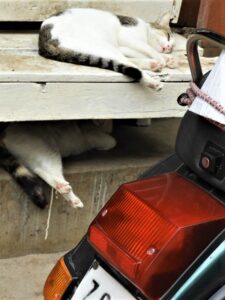 dawn, cruising slowly by, voices likely discussing the catch (good, or bad); is that what I saw in the pile just inside the fishy-smelling building? The market is (understandably) a paradise for cats; as I walked along I spotted cats everywhere; licking their paws, taking a snooze, their little sniffers dreaming sweet, sweet dreams.
dawn, cruising slowly by, voices likely discussing the catch (good, or bad); is that what I saw in the pile just inside the fishy-smelling building? The market is (understandably) a paradise for cats; as I walked along I spotted cats everywhere; licking their paws, taking a snooze, their little sniffers dreaming sweet, sweet dreams.
 I was headed for the Zanzibar Coffee House. Tour Guide Said worked it out with Ali, our driver, to get me as close as possible about the time he and Rick would arrive on the Walking Tour. The “closest” was a 10-minute walk for me (slowly, slowly, pole, pole) through the swirling noise and smells and color where everything was for sale but pig. Spice Island spices, yes. Octopus, changu (a favorite fish), chicken, piles of seafood; bananas, oranges, avocado, pineapple. Shoes. Electronics. What fascinated me most? We’d seen piles of produce and clothing and other tradeable items at markets all the way through Kenya and Tanzania, so crowds and color were not unusual to my eyes. Here though, everything was compressed; tucked into the narrowest of spaces, which seemed to magnify the scene. A dazzling mixture of Arab, Persian, Indian, European and African styles and traditions! Stone Town’s cast of characters is better than a Hollywood movie set. Action! Camera!
I was headed for the Zanzibar Coffee House. Tour Guide Said worked it out with Ali, our driver, to get me as close as possible about the time he and Rick would arrive on the Walking Tour. The “closest” was a 10-minute walk for me (slowly, slowly, pole, pole) through the swirling noise and smells and color where everything was for sale but pig. Spice Island spices, yes. Octopus, changu (a favorite fish), chicken, piles of seafood; bananas, oranges, avocado, pineapple. Shoes. Electronics. What fascinated me most? We’d seen piles of produce and clothing and other tradeable items at markets all the way through Kenya and Tanzania, so crowds and color were not unusual to my eyes. Here though, everything was compressed; tucked into the narrowest of spaces, which seemed to magnify the scene. A dazzling mixture of Arab, Persian, Indian, European and African styles and traditions! Stone Town’s cast of characters is better than a Hollywood movie set. Action! Camera!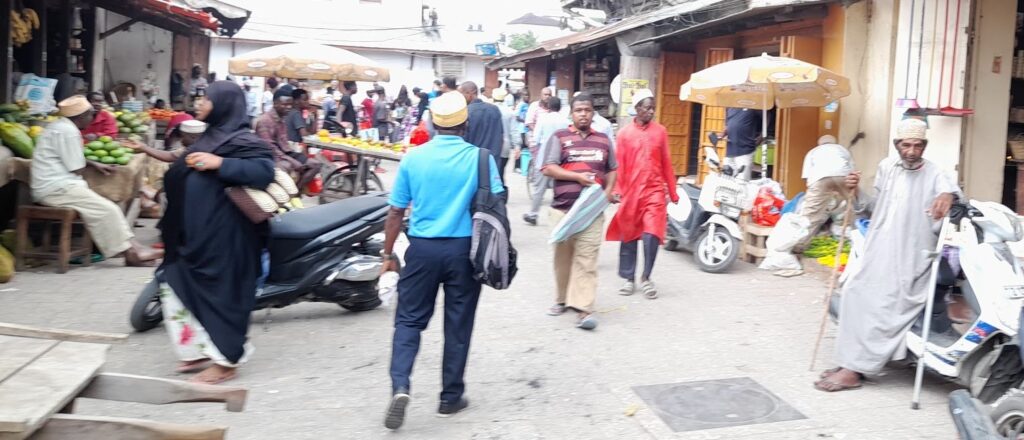
Some things to get a picture of: traditional buildings have a baraza, a long stone bench for resting or socializing along the outside walls; it’s an elevated sidewalk if it rains too much. Most buildings have large verandas (look up) protected by carved wooden balustrades. The  town is a maze of narrow alleys and most streets are too narrow for cars, so it’s crowded with bicycles and motorbikes. Darajani Market, which has been around since 1904, is on the edge of Stone Town, extending to the wider street along the seafront. Another interesting market – actually a giant open-air restaurant
town is a maze of narrow alleys and most streets are too narrow for cars, so it’s crowded with bicycles and motorbikes. Darajani Market, which has been around since 1904, is on the edge of Stone Town, extending to the wider street along the seafront. Another interesting market – actually a giant open-air restaurant 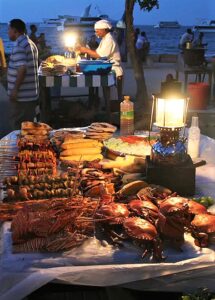 – is in Forodhani Park, right on the waterfront. Every night food stalls set up there to serve every kind of seafood you can imagine; people come in droves (locals and tourists alike); hey, Anthony Bourdain did a feature on it; he had octopus! Did I get my Zanzibarian coffee today? I did indeed, in an authentic Arabic house constructed in 1885 by Sir Tharia Topan, Wazir to Sultan Said Barghash. A wazir is an aide, or minister, by the way. More on sultans coming up.
– is in Forodhani Park, right on the waterfront. Every night food stalls set up there to serve every kind of seafood you can imagine; people come in droves (locals and tourists alike); hey, Anthony Bourdain did a feature on it; he had octopus! Did I get my Zanzibarian coffee today? I did indeed, in an authentic Arabic house constructed in 1885 by Sir Tharia Topan, Wazir to Sultan Said Barghash. A wazir is an aide, or minister, by the way. More on sultans coming up.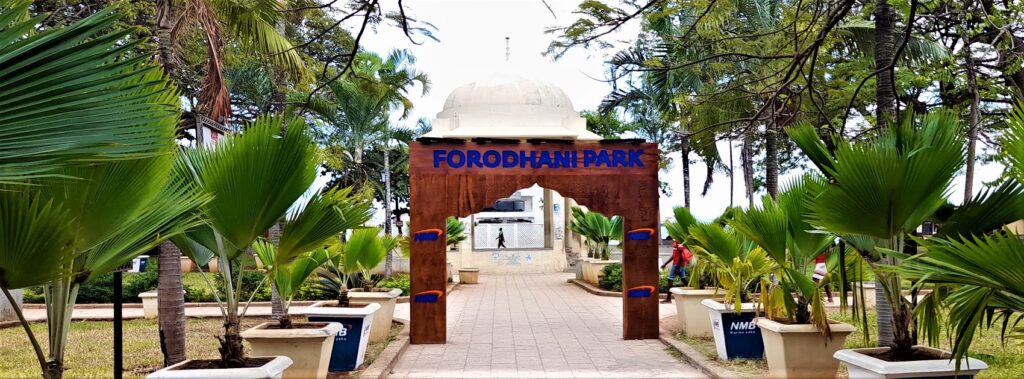
Can you find our guide Said? He’s wearing the gold hat (kufi) and the blue shirt.
“To Market, To Market” is a folk nursery rhyme based upon the traditional rural activity of going to a market where agricultural products would be bought and sold. Typically chanted when bouncing baby on your knee, it came to mind while I was walking “the market” today.
- To market, to market, to buy a fat pig,
- Home again, home again, jiggety-jig.
- To market, to market, to buy a fat hog,
- Home again, home again, jiggety-jog.
- To market, to market to buy a plum cake,
- Home again, home again, market is late.
- To market, to market, to buy a plum bun,
- Home again, home again, market is done.
Zanzibar Serena Hotel https://www.serenahotels.com/zanzibar
Zanzibar Coffee House https://www.utengule.com/zanzibar-coffee-house
Fisherman’s Tours https://fishermantours.com/
Next Post: Sultans and Slavers
» posted on Monday, September 26th, 2022 by Linda Lou Burton
Freddie & The Doors
Linda Lou Burton posting from Zanzibar Serena Hotel, Stone Town, Zanzibar, Tanzania –  Is this going to be a post about rock stars? Well yes, and no. Those of a certain generation might think “rock stars” when you see The Doors; likewise when you see the name Freddie. Freddie Mercury. Queen. The Doors. They were the noise of the 60s, and onward; controversial and influential, changing music and leaving behind songs that stick with us to this day. And they were flamboyant! So it was a bit of a surprise to realize our hotel was just around the corner from the Freddie Mercury museum in Stone Town, Zanzibar, a city steeped in traditions that go back to Medieval times. Freddie didn’t BECOME a rock star in this setting, but he was BORN in Stone Town on September 5, 1946, as Farrokh Bulsara to
Is this going to be a post about rock stars? Well yes, and no. Those of a certain generation might think “rock stars” when you see The Doors; likewise when you see the name Freddie. Freddie Mercury. Queen. The Doors. They were the noise of the 60s, and onward; controversial and influential, changing music and leaving behind songs that stick with us to this day. And they were flamboyant! So it was a bit of a surprise to realize our hotel was just around the corner from the Freddie Mercury museum in Stone Town, Zanzibar, a city steeped in traditions that go back to Medieval times. Freddie didn’t BECOME a rock star in this setting, but he was BORN in Stone Town on September 5, 1946, as Farrokh Bulsara to  Indian-born parents Bomi and Jer Bulsara. Bomi was a cashier at the British Colonial Office in Stone Town; Zanzibar was a British Protectorate at the time. Farrokh spent most of his school years in India, coming back to Zanzibar in 1963 to be with his parents; but in spring of 1964 the family fled to England to escape the violence of the revolution against the Sultan of Zanzibar and the mainly Arab government. Farrokh changed his name to Freddie Mercury in England and you know the rest of that story. (Or not.) The Museum was opened in Zanzibar November 24, 2019, commemorating the 28th anniversary of Freddie’s death.
Indian-born parents Bomi and Jer Bulsara. Bomi was a cashier at the British Colonial Office in Stone Town; Zanzibar was a British Protectorate at the time. Farrokh spent most of his school years in India, coming back to Zanzibar in 1963 to be with his parents; but in spring of 1964 the family fled to England to escape the violence of the revolution against the Sultan of Zanzibar and the mainly Arab government. Farrokh changed his name to Freddie Mercury in England and you know the rest of that story. (Or not.) The Museum was opened in Zanzibar November 24, 2019, commemorating the 28th anniversary of Freddie’s death.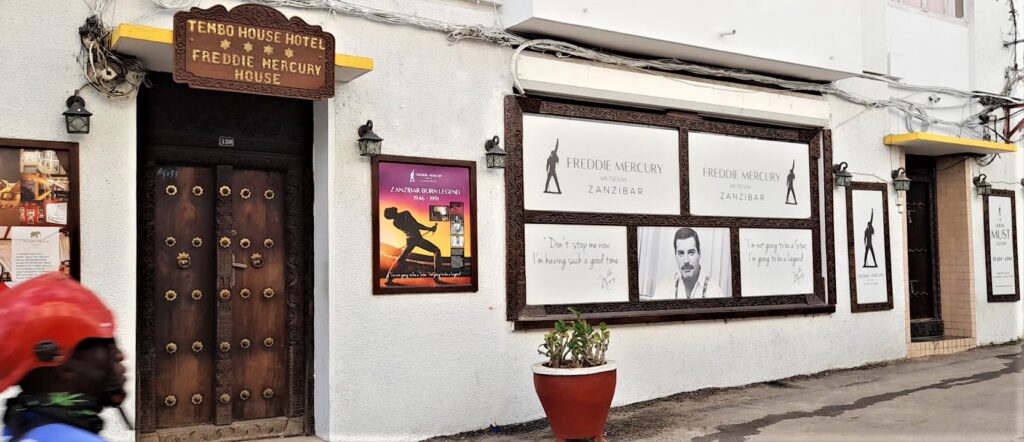
“We can walk there together later on our own,” we agreed this morning as Rick headed out to begin his organized City Walking Tour. Well, we didn’t. But Rick walked past it on his tour, and I rode past it in the tour van later. Ha! At least we both saw the beautiful DOOR out front.
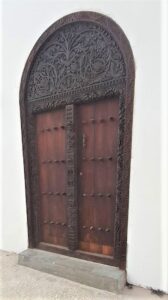 NOW TO THE DOORS: Zanzibar is FAMOUS for its DOORS! As it should be; they are elegant, intricate, beautiful, and long-lasting bits of “history we like to look at.” Fortunately, craftsmen and artists and entrepreneurs will make one for you in this day and time, for a price of course. Rick and I were just intent on looking AT them today, and thinking about events that took place on either side of them. What stories they could tell! The buildings in Stone Town are old; the streets and alleyways are narrow and crowded. We both took photos; of doors surrounded by people, cats, cars, life in a hurry or life over a cup of coffee. I give you a few descriptive bits (don’t get bored) about the meaning of the designs, see what you can pick out on the photos of the doors we saw. How old would you guess each door to be? Consider this:
NOW TO THE DOORS: Zanzibar is FAMOUS for its DOORS! As it should be; they are elegant, intricate, beautiful, and long-lasting bits of “history we like to look at.” Fortunately, craftsmen and artists and entrepreneurs will make one for you in this day and time, for a price of course. Rick and I were just intent on looking AT them today, and thinking about events that took place on either side of them. What stories they could tell! The buildings in Stone Town are old; the streets and alleyways are narrow and crowded. We both took photos; of doors surrounded by people, cats, cars, life in a hurry or life over a cup of coffee. I give you a few descriptive bits (don’t get bored) about the meaning of the designs, see what you can pick out on the photos of the doors we saw. How old would you guess each door to be? Consider this:
- The Swahili or Zanzibari doors were developed during the Middle Ages.
- The oldest are found along the East African coast from Mozambique to Kenya.
- The highest concentration of remaining doors is in Zanzibar’s Stone Town.
- They were created for the wealthy: sultans and slave traders and caravan traders.
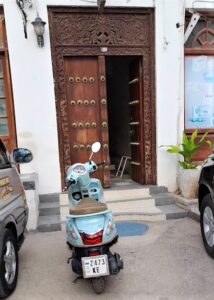 The Swahili designs are divided into two types; the classic rectangular is more geometric with more pre-Islamic forms; with motifs of lotus, rosettes, chain, date palms, and fish. Later designs changed to arched lintels; these doors have more floral patterns due to Indian inspiration as more Indian immigrants came to East Africa. The chain was replaced with beads on the frame; the fish became a vase with vines. The center of the lintel in both the rectangular and arched style usually has an Arabic inscription – a quote from the Koran, the date of completion of the door, or the owner’s initial and/or name. The doors themselves are not carved, instead, they are studded with metal tiers usually made of Brass or cast iron. The wood used for the most expensive doors is African ebony or imported teak.
The Swahili designs are divided into two types; the classic rectangular is more geometric with more pre-Islamic forms; with motifs of lotus, rosettes, chain, date palms, and fish. Later designs changed to arched lintels; these doors have more floral patterns due to Indian inspiration as more Indian immigrants came to East Africa. The chain was replaced with beads on the frame; the fish became a vase with vines. The center of the lintel in both the rectangular and arched style usually has an Arabic inscription – a quote from the Koran, the date of completion of the door, or the owner’s initial and/or name. The doors themselves are not carved, instead, they are studded with metal tiers usually made of Brass or cast iron. The wood used for the most expensive doors is African ebony or imported teak.
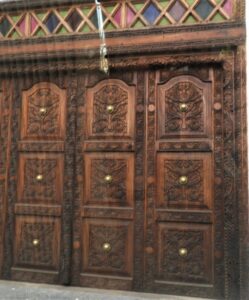
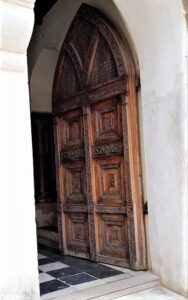
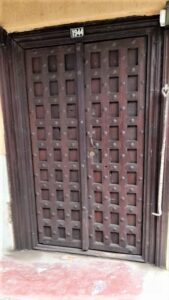

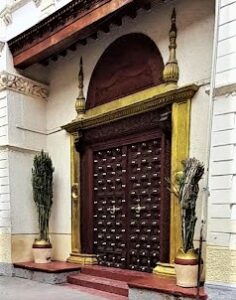
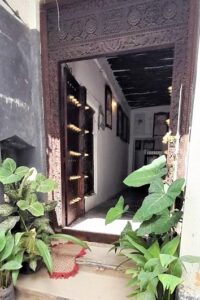
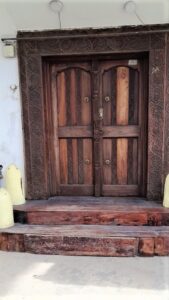
Zanzibar Serena Hotel https://www.serenahotels.com/zanzibar
Fisherman’s Tours https://fishermantours.com/
Freddie Mercury Museum https://freddiemercurymuseum.com/
Next Post: To Market, To Market
» posted on Sunday, September 25th, 2022 by Linda Lou Burton
The Pause Button
Linda Lou Burton posting from Zanzibar Serena Hotel, Stone Town, Zanzibar, Tanzania – 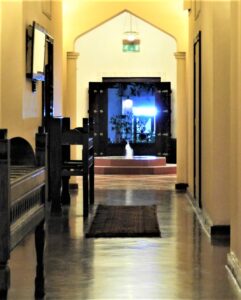 The telephone was ringing. I left my peaceful spot on the porch, wondering who would be calling so early on a Sunday morning. It was the front desk. “Your Tour Guide is in the lobby,” I was informed. Still in my jammies, I hastily threw on yesterday’s clothes, grabbed all the Globus info, and headed down the hall. A smiling man wearing a Fisherman’s Tours badge, said “Good morning, Madame. I am Said, and I have come to take you on the Walking Tour of the city.” I shook my head and began my apology. “I am so sorry! I guess the message didn’t get through. I told our Transport Driver yesterday we wanted to have a day of rest and do our tours tomorrow. I am very sorry for the inconvenience. We are just too tired to do anything today! Plus, we want to change the tours that were picked for us. I can’t do the walking City
The telephone was ringing. I left my peaceful spot on the porch, wondering who would be calling so early on a Sunday morning. It was the front desk. “Your Tour Guide is in the lobby,” I was informed. Still in my jammies, I hastily threw on yesterday’s clothes, grabbed all the Globus info, and headed down the hall. A smiling man wearing a Fisherman’s Tours badge, said “Good morning, Madame. I am Said, and I have come to take you on the Walking Tour of the city.” I shook my head and began my apology. “I am so sorry! I guess the message didn’t get through. I told our Transport Driver yesterday we wanted to have a day of rest and do our tours tomorrow. I am very sorry for the inconvenience. We are just too tired to do anything today! Plus, we want to change the tours that were picked for us. I can’t do the walking City  Tour, and we both want to go to a Spice Farm instead of walking in the Jozani Forest as you have scheduled, but we need to do that tomorrow. Can we please arrange that? I talked to the Globus main office about these changes months ago, but they told me I’d need to work with you directly once I got here.” Said was most agreeable and kind, as I kept apologizing for his troubles. We agreed on 9 AM tomorrow for Rick to do the Walking Tour of the City, with the driver getting me to one of the places I wanted to visit, the Zanzibar Coffee House. Then lunch, and an afternoon tour of a spice farm, which would take us farther inland on the island. We said our farewells, “Until tomorrow, then.”
Tour, and we both want to go to a Spice Farm instead of walking in the Jozani Forest as you have scheduled, but we need to do that tomorrow. Can we please arrange that? I talked to the Globus main office about these changes months ago, but they told me I’d need to work with you directly once I got here.” Said was most agreeable and kind, as I kept apologizing for his troubles. We agreed on 9 AM tomorrow for Rick to do the Walking Tour of the City, with the driver getting me to one of the places I wanted to visit, the Zanzibar Coffee House. Then lunch, and an afternoon tour of a spice farm, which would take us farther inland on the island. We said our farewells, “Until tomorrow, then.”
Rick was still sitting on the porch when I returned. “A whole day of nothing planned!” I said. “For the first time in sixteen days, we can do just what we want to do, when we want to do it. And that includes doing nothing.” “Sounds like a plan to me!” he replied. Here’s what we did.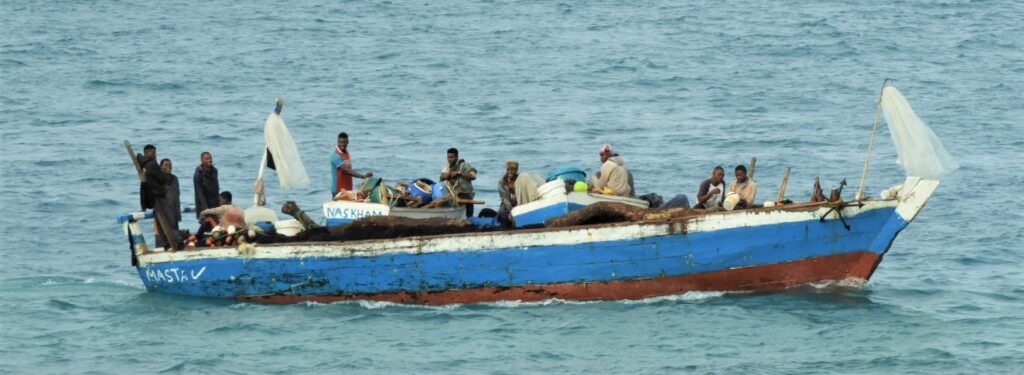
- Watched the boats go by.
- Watched the tide go out.
- Watched people walking on the beach.
- Watched people pretending to swim in the ocean.
- Watched the tide come in.
- Wandered around our pool.
- Wandered the hotel grounds.
- Ate lunch in the Baharia Restaurant with open-air windows overlooking the beach.
- Took pictures of the flowers.
- Took pictures of the people. (And yes, the gal in the scruffy jeans shorts is the one in the teeny-weeny bikini, surprise!)
It’s hard to do ABSOLUTELY nothing. As our gang-mate Ed said often, while we were on safari, “There’s always something to look at.” Even when you hit the pause button.
Zanzibar Serena Hotel https://www.serenahotels.com/zanzibar
Fisherman’s Tours https://fishermantours.com/
Next Post: Freddie & The Doors
» posted on Saturday, September 24th, 2022 by Linda Lou Burton
Well, There It Is
Linda Lou Burton posting from Zanzibar Serena Hotel, Stone Town, Zanzibar, Tanzania – I’m not just looking at the Indian Ocean right now. I am smelling it, hearing it, and within  inches of touching it. Which happens to be the next part of my plan. You see, there are five oceans in the world, and they cover 70% of the Earth’s surface. So if you plan to See The World, you’re going to have to swim, cruise, or fly over a lot of water! And naturally, you’ll want to get your foot in it. I may have come in contact with Atlantic waters when I was 5 and Dad and Mom took me swimming in Virginia’s York River. But that’s a stretch, although salt water does come inland that far. Certainly during the 60s and 70s I spent time on the Atlantic seaboard with my kids, wading and splashing from Florida all the way to Maine. In 1978 my sons and I went plowing into the Pacific waters at Santa Monica Beach, after a long drive cross-country to California. Then I had 25 years of living on the West Coast and enjoying the Pacific waters from California to Washington state. It was 2005 when I did the quirky thing of going NORTH of the Artic Circle and SOUTH of
inches of touching it. Which happens to be the next part of my plan. You see, there are five oceans in the world, and they cover 70% of the Earth’s surface. So if you plan to See The World, you’re going to have to swim, cruise, or fly over a lot of water! And naturally, you’ll want to get your foot in it. I may have come in contact with Atlantic waters when I was 5 and Dad and Mom took me swimming in Virginia’s York River. But that’s a stretch, although salt water does come inland that far. Certainly during the 60s and 70s I spent time on the Atlantic seaboard with my kids, wading and splashing from Florida all the way to Maine. In 1978 my sons and I went plowing into the Pacific waters at Santa Monica Beach, after a long drive cross-country to California. Then I had 25 years of living on the West Coast and enjoying the Pacific waters from California to Washington state. It was 2005 when I did the quirky thing of going NORTH of the Artic Circle and SOUTH of 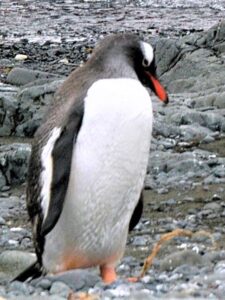 the Antarctic on the first day of summer at each. So, June 2005 I put a boot into the Arctic Ocean, and December 2005, a boot into the Southern Ocean. Yes, for both of those, I was surrounded by snow; a guide had his rifle ready on Artic Ocean day and barely agreed to let me out of the Hummer. “If a polar bear is coming, I can’t see him until he’s close,” he warned. In Antarctica, the penguins were much less a threat; the idea there was to protect THEM from US; my boots were sanitized before going ashore. It’s 2022 now, and here I am, FINALLY, at Ocean #5 – there it is – the bluest, warmest, and 3rd largest ocean in the world. Pardon me while I sit on my porch just 20 feet away from it. I’ll do the touching thing tomorrow, but right now I’m going to look at it until it’s pitch plum dark. Room service, please?
the Antarctic on the first day of summer at each. So, June 2005 I put a boot into the Arctic Ocean, and December 2005, a boot into the Southern Ocean. Yes, for both of those, I was surrounded by snow; a guide had his rifle ready on Artic Ocean day and barely agreed to let me out of the Hummer. “If a polar bear is coming, I can’t see him until he’s close,” he warned. In Antarctica, the penguins were much less a threat; the idea there was to protect THEM from US; my boots were sanitized before going ashore. It’s 2022 now, and here I am, FINALLY, at Ocean #5 – there it is – the bluest, warmest, and 3rd largest ocean in the world. Pardon me while I sit on my porch just 20 feet away from it. I’ll do the touching thing tomorrow, but right now I’m going to look at it until it’s pitch plum dark. Room service, please?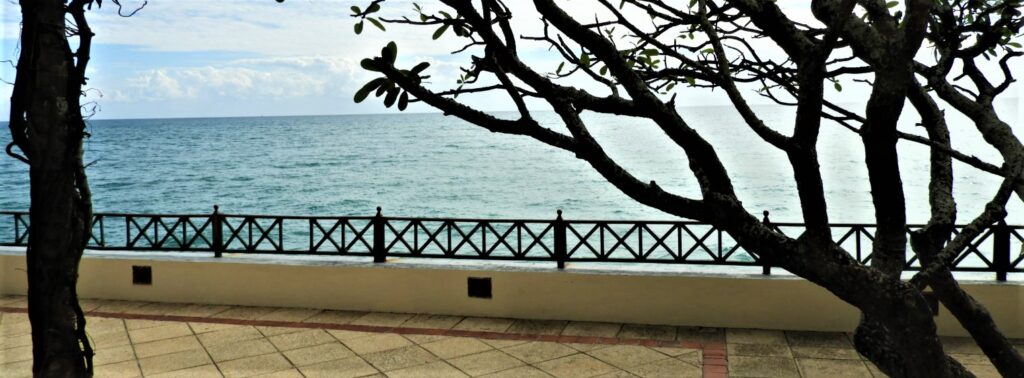
Know Your Oceans
- Pacific Ocean: 104,800,000 sq miles between Asia and Australasia and the Americas.
- Atlantic Ocean: 52,899,000 sq miles between the Americas and Europe and Africa.
- Indian Ocean: 43,844,000 sq miles between southern Asia, Africa and Australia.
- Southern Ocean: 13,645,000 sq miles between Antarctica and the Pacific, Atlantic and Indian oceans.
- Arctic Ocean: 9,667,000 sq miles between northern North America and Eurasia in the Arctic.
Zanzibar Serena Hotel https://www.serenahotels.com/zanzibar
Next Post: The Pause Button
» posted on Saturday, September 24th, 2022 by Linda Lou Burton
A Story of Water
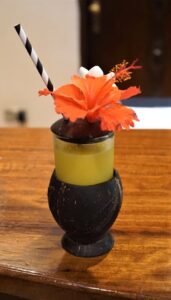 Linda Lou Burton posting from Zanzibar Serena Hotel, Stone Town, Zanzibar, Tanzania – This is the prettiest drink ever! And I promise, the most welcomed. We arrived at our exotic Serena-By-The-Sea (Kingdom by the sea? Poe) just after 3 PM, with a poet’s bag of stories (I shall be telling this with a sigh, somewhere ages and ages hence.” Frost). There’s the story of Ben’s flight-booking surprise, that turned into turmoil for everyone. There’s the story of our strange pilot (Santa?) who “spoke not a word but went straight to his work” for the entire two-hour flight. There’s the story of Immigrations (Give me your tired… Lazarus) where, even though Zanzibar is IN Tanzania, and we were IN Tanzania on a Tanzanian visa as evidenced in our passports, we had to fill out paperwork for Zanzibar. And then there’s the story of water.
Linda Lou Burton posting from Zanzibar Serena Hotel, Stone Town, Zanzibar, Tanzania – This is the prettiest drink ever! And I promise, the most welcomed. We arrived at our exotic Serena-By-The-Sea (Kingdom by the sea? Poe) just after 3 PM, with a poet’s bag of stories (I shall be telling this with a sigh, somewhere ages and ages hence.” Frost). There’s the story of Ben’s flight-booking surprise, that turned into turmoil for everyone. There’s the story of our strange pilot (Santa?) who “spoke not a word but went straight to his work” for the entire two-hour flight. There’s the story of Immigrations (Give me your tired… Lazarus) where, even though Zanzibar is IN Tanzania, and we were IN Tanzania on a Tanzanian visa as evidenced in our passports, we had to fill out paperwork for Zanzibar. And then there’s the story of water.
I was the last person on the plane (slowly, slowly; pole, pole) being pushed and pulled up the tiny steps and squeezed into the last seat. The person carrying my backpack threw it into the pile of luggage secured behind a cloth curtain at the back. As the plane taxied down the runway, my seatmate began recording our flight, his camera-on-a-stick held to the window, technology capturing his dull monotone voice. I looked around, surveying my surroundings; the plane had 1-2 seating with me in the aisle seat. Friedrich (I decided to name him) was on my right and his traveling partner Frieda (as I named her) had the single window seat to the left of me (yes, they had grabbed both windows). About 30 minutes into the flight, Friedrich reached into his backpack and pulled out two water bottles. He leaned over me and handed one across the aisle to Frieda, then tucked one into his seat pocket, unopened. This set off the “thirst command” in my head, and I realized that MY water bottle was in my backpack, and my backpack was way beyond my reach, oh criminy! After 30 minutes of staring at those two unopened water bottles, I nudged Friedrich’s arm and said, in gesturing English, “I need some water badly but mine is in the back. I’ll be glad to pay you for your water bottle.” He shook his head and frowned. “No. This is my water.” Then I started coughing. I didn’t MEAN to, I swear! But I couldn’t stop coughing! My mouth was completely dry; I was reminded of those poor zebras in Amboseli, dying of thirst. My throat hurt. I was thinking evil thoughts. Friedrich never looked my way, nor did he ever open his water bottle. Frieda didn’t either.
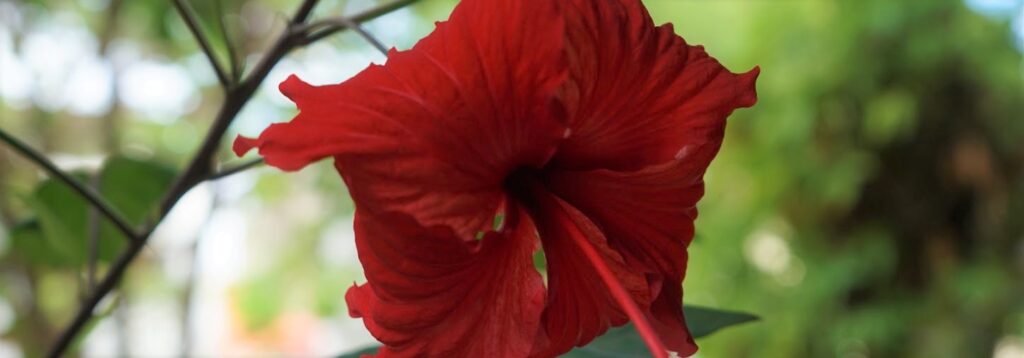 This beautiful drink I’m sipping now, in the lobby of my Serena-by-the-Indian Ocean, isn’t the much-craved water I needed so badly on the plane, but bungo juice, which is found only in Zanzibar; it tastes of pineapple, mango, and orange; refreshing but not too sweet. The flower is hibiscus; red and orange blooms surround the hotel. A poet would have a word for a place like this, I’m thinking, as I looked past the massive hand-carved doors to the lively street scene out front. “Friedrich and Frieda will probably hate it here” is the best line I’ve got.
This beautiful drink I’m sipping now, in the lobby of my Serena-by-the-Indian Ocean, isn’t the much-craved water I needed so badly on the plane, but bungo juice, which is found only in Zanzibar; it tastes of pineapple, mango, and orange; refreshing but not too sweet. The flower is hibiscus; red and orange blooms surround the hotel. A poet would have a word for a place like this, I’m thinking, as I looked past the massive hand-carved doors to the lively street scene out front. “Friedrich and Frieda will probably hate it here” is the best line I’ve got.
A record of our day, so far, beginning at Seronera Airstrip. See, I had water with me!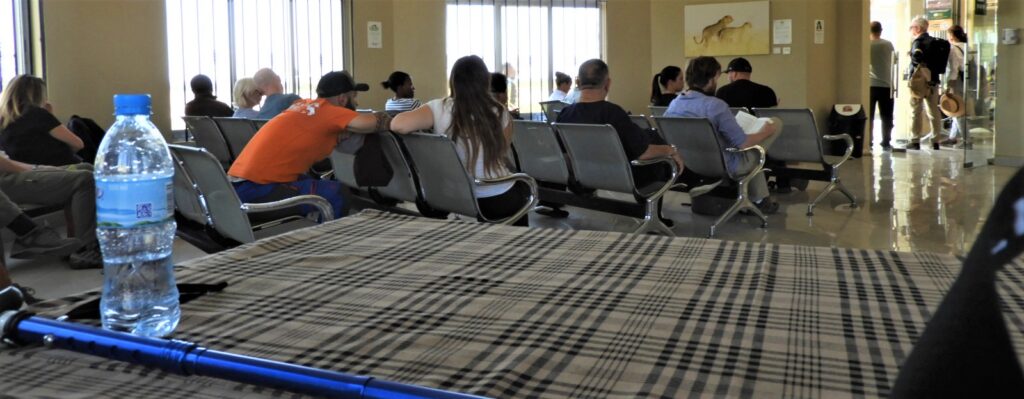
Zanzibar Serena Hotel https://www.serenahotels.com/zanzibar

